Paper Menu >>
Journal Menu >>
 J. Serv. Sci. & Management. 2008, 1: 29-49 Published Online June 2008 in SciRes (www.SRPublishing.org/journal/jssm) Copyright © 2008 SciRes JSSM Value Delivery Systems under the Instantaneous Competition Guo-Jun Ji School of Management, Xiamen University, Xiamen Fujian, 361005, China ABSTRACT In this paper, the necessary conditions and the components of the operation of value delivery under the instantaneous competition system are analyzed; the every node enterprise to make clear that the function of each of them in value creation and increase is discussed. The processes and model of a value delivery system are discussed in this paper, and the processes content and model are presented, we firstly discuss the operational flowchart and classification of the value delivery under the instantaneous competition environment. Secondly, we analyze the tactics of the instantaneous competition in supply chain system and the marketing system, both of which compose the whole value delivery system. Thirdly, we analyze some factors that must be controlled in value delivery system. Finally, we set up a multi-objective optimization model, which is a mixed-integer nonlinear programming problem. And a case study illustrates our conclusions. Keywords: Value delivery system, Instantaneous competition, Multi-objective o ptimization 1. Introduction The essence of time-based competition involves compressing time in every phase of the product development and delivery cycle, which becomes one of the most important strategies for enterprises development in nowadays. The competition mode is called instantaneous competition in this paper. Enterprises take quick respond to the demands of customers and rapid introduction of new products as the main strategic target and possess competitive cost and service quality at the same time, so they have to reduce the process time of service (involved product) planning and developing, producing, selling and transporting. Under the globalization environment, in which product life cycle becomes shorter and demand forecast is harder, the instantaneous competition between enterprises is very necessary. Value delivery system (VDS) is one of the most important processes, which includes the whole supply chain system and the marketing network of the service. The operational objective of VDS is to maximize the value that deliver to customer and realize the profit of member companies in system which obtained by participation in value creation. According to the different functions, a VDS can be divided into two portions: one is the supply chain system, and the other is the marketing system, which will be discussed separately later. However, we must consider the influence on service or band value both from the strategy selection in supply chain system and from the implement effect of marketing policy synthetically. Research on VDS under the instantaneous competition is to control the service stream, stock and cost to maximize the value that delivered from the system to customers, and considering the influence of product lifecycle on the product demand and price simultaneity. It is because that demand and price of the product are always the main factors to weigh whether a product possess advantages in competition or not. And under the instantaneous competition, these factors are also sensitive to time, each of which change dramatically in different process of product’s lifecycle. So, in this paper, we will forecast the product’s demand and price at some periods by using some forecasting model in marketing and the results will be involved to compute how the value is in the VDS, which is the criterion to consider the advantage that the company. With the global economy development, a remarkable phenomenon shows that the VDS exists to create value for customers by supplying demand products and services. VDS and its abilities are at the heart of every firm and, more than anything else, determine whether the firm survives in the marketplace or disappear into bankruptcy or reengineered. VDS may cover many forms as illustrated by these two cases [8] as follows: (1) Facing increased competition and customers who are smarter, more demanding, and less brand-loyal, McDonald’s is reevaluating the way it makes some of the items on its menu. For example, it is considering a switch to a hamburger bun that does not require toasting. In trial tests, customers seemed to prefer the new bun’s taste and texture. Furthermore, not toasting buns should translate into substantial cost savings due to reduced preparation time and the elimination of commercial toasting 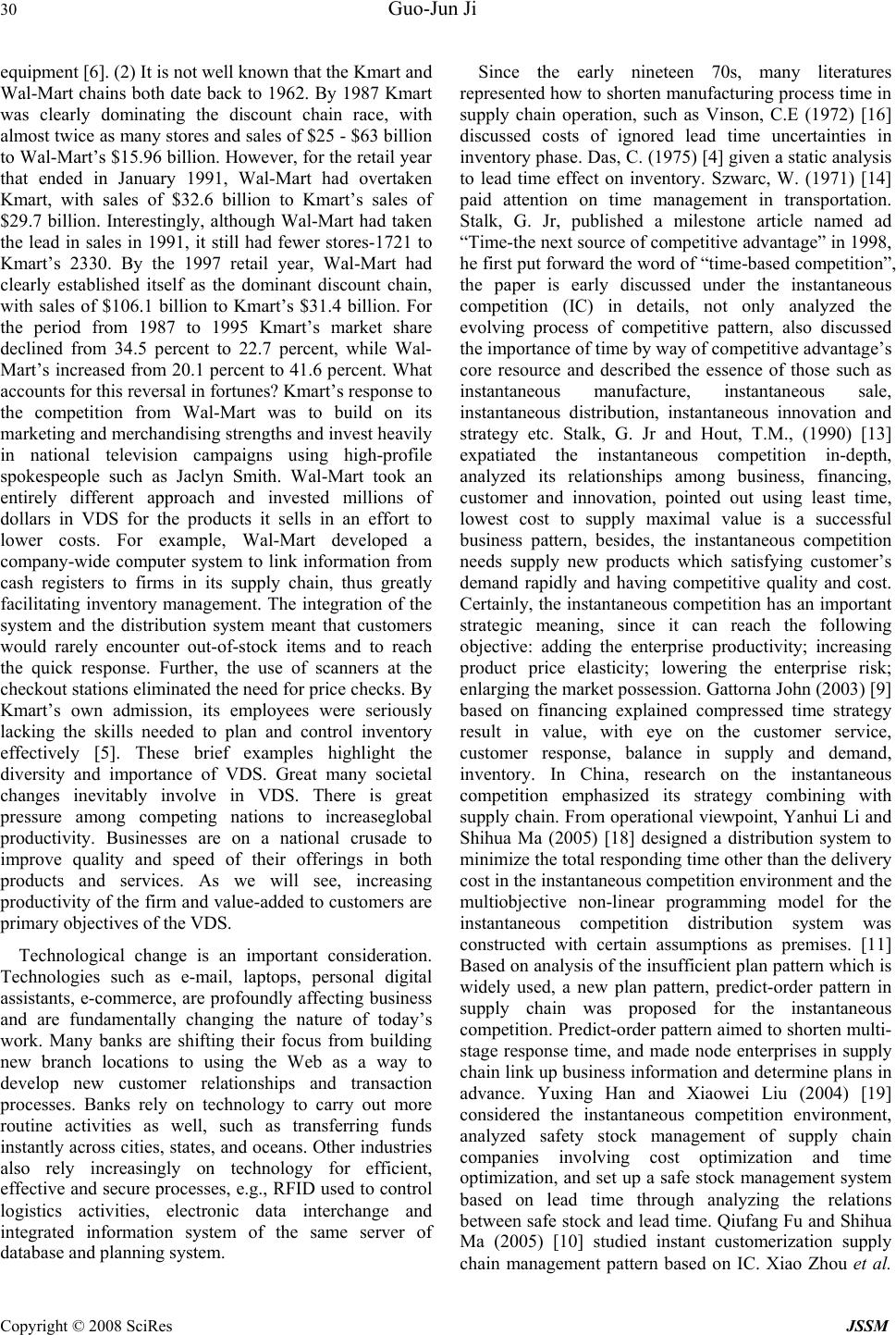 30 Guo-Jun Ji Copyright © 2008 SciRes JSSM equipment [6]. (2) It is not well known that the Kmart and Wal-Mart chains both date back to 1962. By 1987 Kmart was clearly dominating the discount chain race, with almost twice as many stores and sales of $25 - $63 billion to Wal-Mart’s $15.96 billion. However, for the retail year that ended in January 1991, Wal-Mart had overtaken Kmart, with sales of $32.6 billion to Kmart’s sales of $29.7 billion. Interestingly, although Wal-Mart had taken the lead in sales in 1991, it still had fewer stores-1721 to Kmart’s 2330. By the 1997 retail year, Wal-Mart had clearly established itself as the dominant discount chain, with sales of $106.1 billion to Kmart’s $31.4 billion. For the period from 1987 to 1995 Kmart’s market share declined from 34.5 percent to 22.7 percent, while Wal- Mart’s increased from 20.1 percent to 41.6 percent. What accounts for this reversal in fortunes? Kmart’s response to the competition from Wal-Mart was to build on its marketing and merchandising strengths and invest heavily in national television campaigns using high-profile spokespeople such as Jaclyn Smith. Wal-Mart took an entirely different approach and invested millions of dollars in VDS for the products it sells in an effort to lower costs. For example, Wal-Mart developed a company-wide computer system to link information from cash registers to firms in its supply chain, thus greatly facilitating inventory management. The integration of the system and the distribution system meant that customers would rarely encounter out-of-stock items and to reach the quick response. Further, the use of scanners at the checkout stations eliminated the need for price checks. By Kmart’s own admission, its employees were seriously lacking the skills needed to plan and control inventory effectively [5]. These brief examples highlight the diversity and importance of VDS. Great many societal changes inevitably involve in VDS. There is great pressure among competing nations to increaseglobal productivity. Businesses are on a national crusade to improve quality and speed of their offerings in both products and services. As we will see, increasing productivity of the firm and value-added to customers are primary objectives of the VDS. Technological change is an important consideration. Technologies such as e-mail, laptops, personal digital assistants, e-commerce, are profoundly affecting business and are fundamentally changing the nature of today’s work. Many banks are shifting their focus from building new branch locations to using the Web as a way to develop new customer relationships and transaction processes. Banks rely on technology to carry out more routine activities as well, such as transferring funds instantly across cities, states, and oceans. Other industries also rely increasingly on technology for efficient, effective and secure processes, e.g., RFID used to control logistics activities, electronic data interchange and integrated information system of the same server of database and planning system. Since the early nineteen 70s, many literatures represented how to shorten manufacturing process time in supply chain operation, such as Vinson, C.E (1972) [16] discussed costs of ignored lead time uncertainties in inventory phase. Das, C. (1975) [4] given a static analysis to lead time effect on inventory. Szwarc, W. (1971) [14] paid attention on time management in transportation. Stalk, G. Jr, published a milestone article named ad “Time-the next source of competitive advantage” in 1998, he first put forward the word of “time-based competition”, the paper is early discussed under the instantaneous competition (IC) in details, not only analyzed the evolving process of competitive pattern, also discussed the importance of time by way of competitive advantage’s core resource and described the essence of those such as instantaneous manufacture, instantaneous sale, instantaneous distribution, instantaneous innovation and strategy etc. Stalk, G. Jr and Hout, T.M., (1990) [13] expatiated the instantaneous competition in-depth, analyzed its relationships among business, financing, customer and innovation, pointed out using least time, lowest cost to supply maximal value is a successful business pattern, besides, the instantaneous competition needs supply new products which satisfying customer’s demand rapidly and having competitive quality and cost. Certainly, the instantaneous competition has an important strategic meaning, since it can reach the following objective: adding the enterprise productivity; increasing product price elasticity; lowering the enterprise risk; enlarging the market possession. Gattorna John (2003) [9] based on financing explained compressed time strategy result in value, with eye on the customer service, customer response, balance in supply and demand, inventory. In China, research on the instantaneous competition emphasized its strategy combining with supply chain. From operational viewpoint, Yanhui Li and Shihua Ma (2005) [18] designed a distribution system to minimize the total responding time other than the delivery cost in the instantaneous competition environment and the multiobjective non-linear programming model for the instantaneous competition distribution system was constructed with certain assumptions as premises. [11] Based on analysis of the insufficient plan pattern which is widely used, a new plan pattern, predict-order pattern in supply chain was proposed for the instantaneous competition. Predict-order pattern aimed to shorten multi- stage response time, and made node enterprises in supply chain link up business information and determine plans in advance. Yuxing Han and Xiaowei Liu (2004) [19] considered the instantaneous competition environment, analyzed safety stock management of supply chain companies involving cost optimization and time optimization, and set up a safe stock management system based on lead time through analyzing the relations between safe stock and lead time. Qiufang Fu and Shihua Ma (2005) [10] studied instant customerization supply chain management pattern based on IC. Xiao Zhou et al. 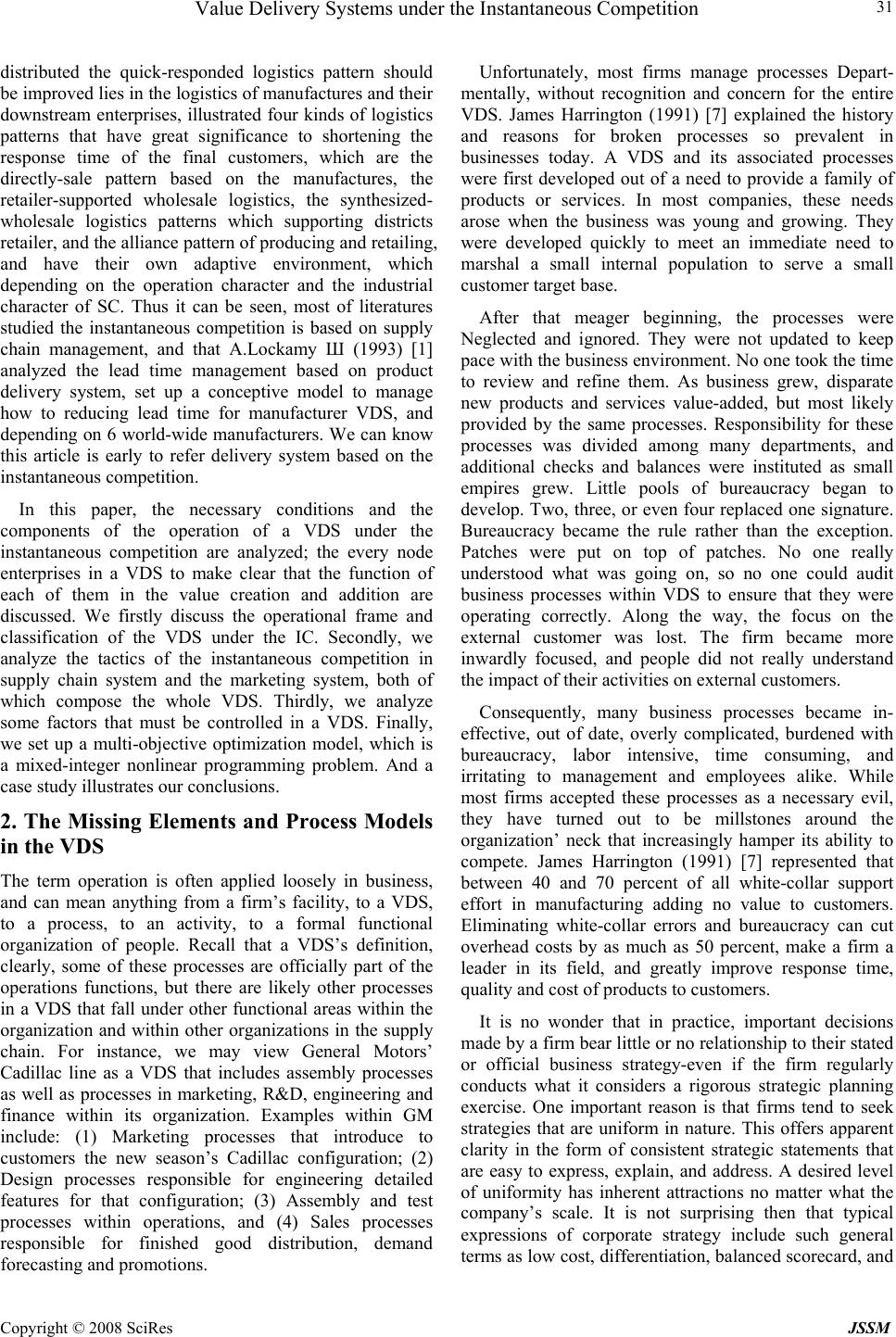 Value Delivery Systems under the Instantaneous Competition Copyright © 2008 SciRes JSSM 31 distributed the quick-responded logistics pattern should be improved lies in the logistics of manufactures and their downstream enterprises, illustrated four kinds of logistics patterns that have great significance to shortening the response time of the final customers, which are the directly-sale pattern based on the manufactures, the retailer-supported wholesale logistics, the synthesized- wholesale logistics patterns which supporting districts retailer, and the alliance pattern of producing and retailing, and have their own adaptive environment, which depending on the operation character and the industrial character of SC. Thus it can be seen, most of literatures studied the instantaneous competition is based on supply chain management, and that A.Lockamy Ш (1993) [1] analyzed the lead time management based on product delivery system, set up a conceptive model to manage how to reducing lead time for manufacturer VDS, and depending on 6 world-wide manufacturers. We can know this article is early to refer delivery system based on the instantaneous competition. In this paper, the necessary conditions and the components of the operation of a VDS under the instantaneous competition are analyzed; the every node enterprises in a VDS to make clear that the function of each of them in the value creation and addition are discussed. We firstly discuss the operational frame and classification of the VDS under the IC. Secondly, we analyze the tactics of the instantaneous competition in supply chain system and the marketing system, both of which compose the whole VDS. Thirdly, we analyze some factors that must be controlled in a VDS. Finally, we set up a multi-objective optimization model, which is a mixed-integer nonlinear programming problem. And a case study illustrates our conclusions. 2. The Missing Elements and Process Models in the VDS The term operation is often applied loosely in business, and can mean anything from a firm’s facility, to a VDS, to a process, to an activity, to a formal functional organization of people. Recall that a VDS’s definition, clearly, some of these processes are officially part of the operations functions, but there are likely other processes in a VDS that fall under other functional areas within the organization and within other organizations in the supply chain. For instance, we may view General Motors’ Cadillac line as a VDS that includes assembly processes as well as processes in marketing, R&D, engineering and finance within its organization. Examples within GM include: (1) Marketing processes that introduce to customers the new season’s Cadillac configuration; (2) Design processes responsible for engineering detailed features for that configuration; (3) Assembly and test processes within operations, and (4) Sales processes responsible for finished good distribution, demand forecasting and promotions. Unfortunately, most firms manage processes Depart- mentally, without recognition and concern for the entire VDS. James Harrington (1991) [7] explained the history and reasons for broken processes so prevalent in businesses today. A VDS and its associated processes were first developed out of a need to provide a family of products or services. In most companies, these needs arose when the business was young and growing. They were developed quickly to meet an immediate need to marshal a small internal population to serve a small customer target base. After that meager beginning, the processes were Neglected and ignored. They were not updated to keep pace with the business environment. No one took the time to review and refine them. As business grew, disparate new products and services value-added, but most likely provided by the same processes. Responsibility for these processes was divided among many departments, and additional checks and balances were instituted as small empires grew. Little pools of bureaucracy began to develop. Two, three, or even four replaced one signature. Bureaucracy became the rule rather than the exception. Patches were put on top of patches. No one really understood what was going on, so no one could audit business processes within VDS to ensure that they were operating correctly. Along the way, the focus on the external customer was lost. The firm became more inwardly focused, and people did not really understand the impact of their activities on external customers. Consequently, many business processes became in- effective, out of date, overly complicated, burdened with bureaucracy, labor intensive, time consuming, and irritating to management and employees alike. While most firms accepted these processes as a necessary evil, they have turned out to be millstones around the organization’ neck that increasingly hamper its ability to compete. James Harrington (1991) [7] represented that between 40 and 70 percent of all white-collar support effort in manufacturing adding no value to customers. Eliminating white-collar errors and bureaucracy can cut overhead costs by as much as 50 percent, make a firm a leader in its field, and greatly improve response time, quality and cost of products to customers. It is no wonder that in practice, important decisions made by a firm bear little or no relationship to their stated or official business strategy-even if the firm regularly conducts what it considers a rigorous strategic planning exercise. One important reason is that firms tend to seek strategies that are uniform in nature. This offers apparent clarity in the form of consistent strategic statements that are easy to express, explain, and address. A desired level of uniformity has inherent attractions no matter what the company’s scale. It is not surprising then that typical expressions of corporate strategy include such general terms as low cost, differentiation, balanced scorecard, and 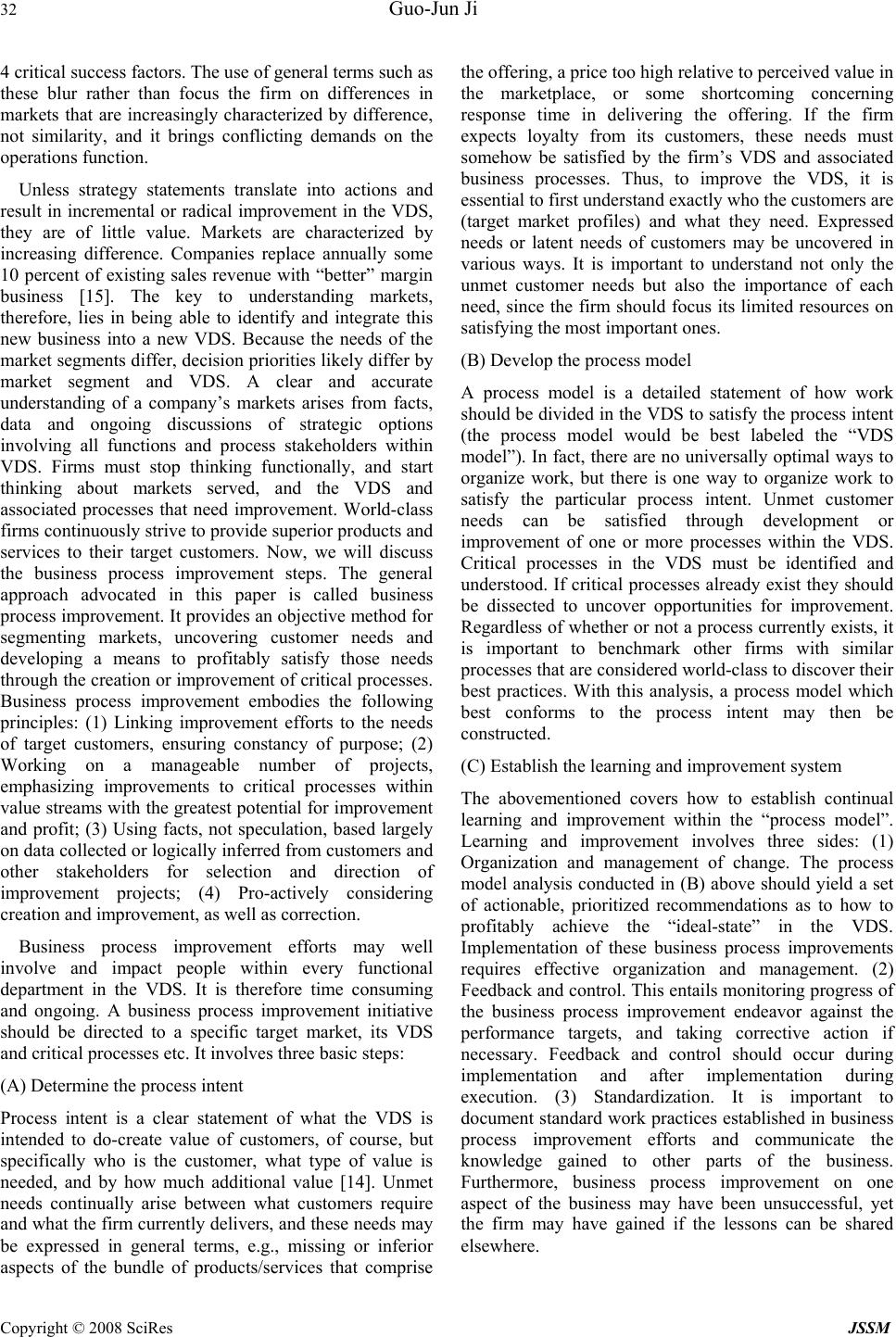 32 Guo-Jun Ji Copyright © 2008 SciRes JSSM 4 critical success factors. The use of general terms such as these blur rather than focus the firm on differences in markets that are increasingly characterized by difference, not similarity, and it brings conflicting demands on the operations function. Unless strategy statements translate into actions and result in incremental or radical improvement in the VDS, they are of little value. Markets are characterized by increasing difference. Companies replace annually some 10 percent of existing sales revenue with “better” margin business [15]. The key to understanding markets, therefore, lies in being able to identify and integrate this new business into a new VDS. Because the needs of the market segments differ, decision priorities likely differ by market segment and VDS. A clear and accurate understanding of a company’s markets arises from facts, data and ongoing discussions of strategic options involving all functions and process stakeholders within VDS. Firms must stop thinking functionally, and start thinking about markets served, and the VDS and associated processes that need improvement. World-class firms continuously strive to provide superior products and services to their target customers. Now, we will discuss the business process improvement steps. The general approach advocated in this paper is called business process improvement. It provides an objective method for segmenting markets, uncovering customer needs and developing a means to profitably satisfy those needs through the creation or improvement of critical processes. Business process improvement embodies the following principles: (1) Linking improvement efforts to the needs of target customers, ensuring constancy of purpose; (2) Working on a manageable number of projects, emphasizing improvements to critical processes within value streams with the greatest potential for improvement and profit; (3) Using facts, not speculation, based largely on data collected or logically inferred from customers and other stakeholders for selection and direction of improvement projects; (4) Pro-actively considering creation and improvement, as well as correction. Business process improvement efforts may well involve and impact people within every functional department in the VDS. It is therefore time consuming and ongoing. A business process improvement initiative should be directed to a specific target market, its VDS and critical processes etc. It involves three basic steps: (A) Determine the process intent Process intent is a clear statement of what the VDS is intended to do-create value of customers, of course, but specifically who is the customer, what type of value is needed, and by how much additional value [14]. Unmet needs continually arise between what customers require and what the firm currently delivers, and these needs may be expressed in general terms, e.g., missing or inferior aspects of the bundle of products/services that comprise the offering, a price too high relative to perceived value in the marketplace, or some shortcoming concerning response time in delivering the offering. If the firm expects loyalty from its customers, these needs must somehow be satisfied by the firm’s VDS and associated business processes. Thus, to improve the VDS, it is essential to first understand exactly who the customers are (target market profiles) and what they need. Expressed needs or latent needs of customers may be uncovered in various ways. It is important to understand not only the unmet customer needs but also the importance of each need, since the firm should focus its limited resources on satisfying the most important ones. (B) Develop the process model A process model is a detailed statement of how work should be divided in the VDS to satisfy the process intent (the process model would be best labeled the “VDS model”). In fact, there are no universally optimal ways to organize work, but there is one way to organize work to satisfy the particular process intent. Unmet customer needs can be satisfied through development or improvement of one or more processes within the VDS. Critical processes in the VDS must be identified and understood. If critical processes already exist they should be dissected to uncover opportunities for improvement. Regardless of whether or not a process currently exists, it is important to benchmark other firms with similar processes that are considered world-class to discover their best practices. With this analysis, a process model which best conforms to the process intent may then be constructed. (C) Establish the learning and improvement system The abovementioned covers how to establish continual learning and improvement within the “process model”. Learning and improvement involves three sides: (1) Organization and management of change. The process model analysis conducted in (B) above should yield a set of actionable, prioritized recommendations as to how to profitably achieve the “ideal-state” in the VDS. Implementation of these business process improvements requires effective organization and management. (2) Feedback and control. This entails monitoring progress of the business process improvement endeavor against the performance targets, and taking corrective action if necessary. Feedback and control should occur during implementation and after implementation during execution. (3) Standardization. It is important to document standard work practices established in business process improvement efforts and communicate the knowledge gained to other parts of the business. Furthermore, business process improvement on one aspect of the business may have been unsuccessful, yet the firm may have gained if the lessons can be shared elsewhere. 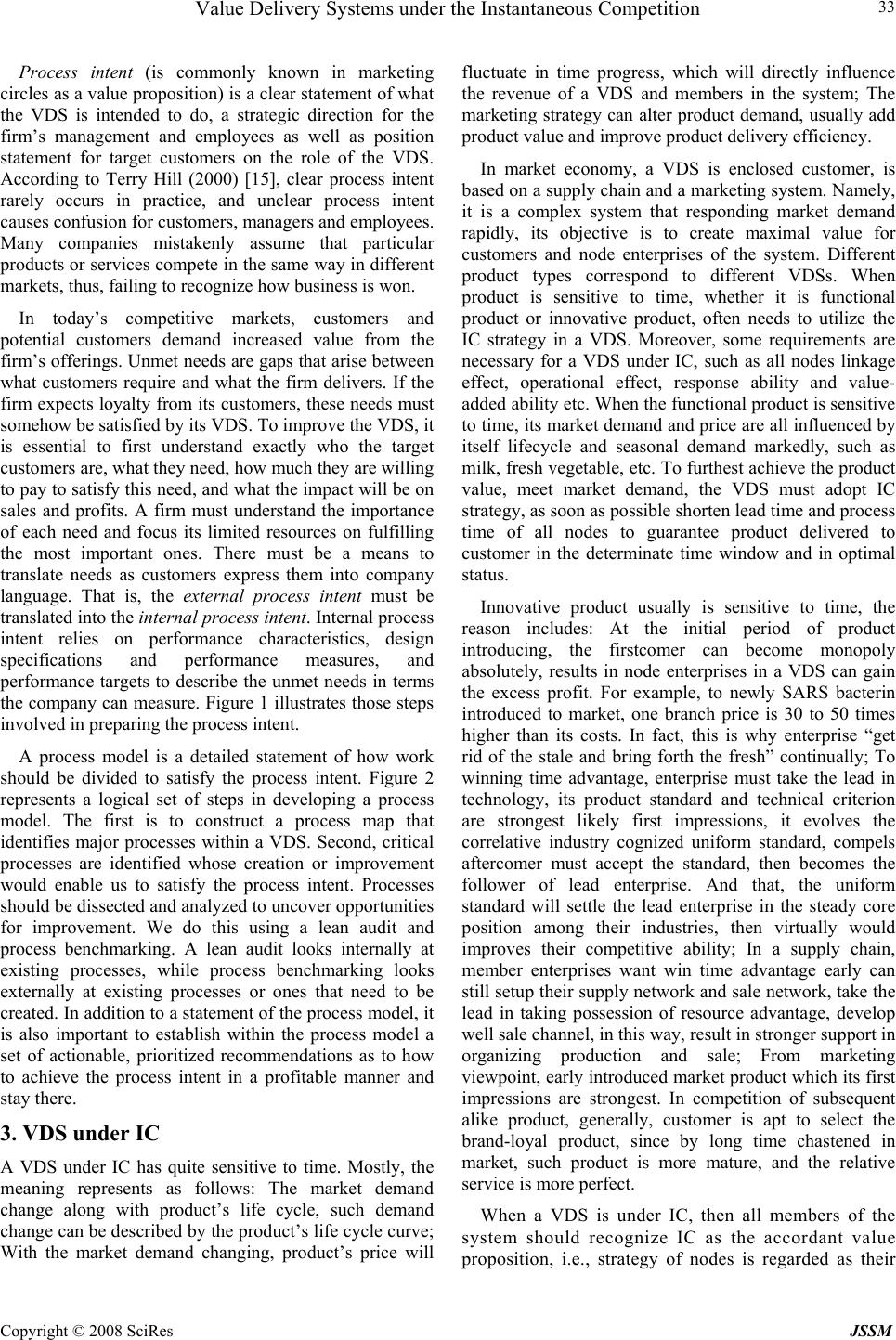 Value Delivery Systems under the Instantaneous Competition Copyright © 2008 SciRes JSSM 33 Process intent (is commonly known in marketing circles as a value proposition) is a clear statement of what the VDS is intended to do, a strategic direction for the firm’s management and employees as well as position statement for target customers on the role of the VDS. According to Terry Hill (2000) [15], clear process intent rarely occurs in practice, and unclear process intent causes confusion for customers, managers and employees. Many companies mistakenly assume that particular products or services compete in the same way in different markets, thus, failing to recognize how business is won. In today’s competitive markets, customers and potential customers demand increased value from the firm’s offerings. Unmet needs are gaps that arise between what customers require and what the firm delivers. If the firm expects loyalty from its customers, these needs must somehow be satisfied by its VDS. To improve the VDS, it is essential to first understand exactly who the target customers are, what they need, how much they are willing to pay to satisfy this need, and what the impact will be on sales and profits. A firm must understand the importance of each need and focus its limited resources on fulfilling the most important ones. There must be a means to translate needs as customers express them into company language. That is, the external process intent must be translated into the internal process intent. Internal process intent relies on performance characteristics, design specifications and performance measures, and performance targets to describe the unmet needs in terms the company can measure. Figure 1 illustrates those steps involved in preparing the process intent. A process model is a detailed statement of how work should be divided to satisfy the process intent. Figure 2 represents a logical set of steps in developing a process model. The first is to construct a process map that identifies major processes within a VDS. Second, critical processes are identified whose creation or improvement would enable us to satisfy the process intent. Processes should be dissected and analyzed to uncover opportunities for improvement. We do this using a lean audit and process benchmarking. A lean audit looks internally at existing processes, while process benchmarking looks externally at existing processes or ones that need to be created. In addition to a statement of the process model, it is also important to establish within the process model a set of actionable, prioritized recommendations as to how to achieve the process intent in a profitable manner and stay there. 3. VDS under IC A VDS under IC has quite sensitive to time. Mostly, the meaning represents as follows: The market demand change along with product’s life cycle, such demand change can be described by the product’s life cycle curve; With the market demand changing, product’s price will fluctuate in time progress, which will directly influence the revenue of a VDS and members in the system; The marketing strategy can alter product demand, usually add product value and improve product delivery efficiency. In market economy, a VDS is enclosed customer, is based on a supply chain and a marketing system. Namely, it is a complex system that responding market demand rapidly, its objective is to create maximal value for customers and node enterprises of the system. Different product types correspond to different VDSs. When product is sensitive to time, whether it is functional product or innovative product, often needs to utilize the IC strategy in a VDS. Moreover, some requirements are necessary for a VDS under IC, such as all nodes linkage effect, operational effect, response ability and value- added ability etc. When the functional product is sensitive to time, its market demand and price are all influenced by itself lifecycle and seasonal demand markedly, such as milk, fresh vegetable, etc. To furthest achieve the product value, meet market demand, the VDS must adopt IC strategy, as soon as possible shorten lead time and process time of all nodes to guarantee product delivered to customer in the determinate time window and in optimal status. Innovative product usually is sensitive to time, the reason includes: At the initial period of product introducing, the firstcomer can become monopoly absolutely, results in node enterprises in a VDS can gain the excess profit. For example, to newly SARS bacterin introduced to market, one branch price is 30 to 50 times higher than its costs. In fact, this is why enterprise “get rid of the stale and bring forth the fresh” continually; To winning time advantage, enterprise must take the lead in technology, its product standard and technical criterion are strongest likely first impressions, it evolves the correlative industry cognized uniform standard, compels aftercomer must accept the standard, then becomes the follower of lead enterprise. And that, the uniform standard will settle the lead enterprise in the steady core position among their industries, then virtually would improves their competitive ability; In a supply chain, member enterprises want win time advantage early can still setup their supply network and sale network, take the lead in taking possession of resource advantage, develop well sale channel, in this way, result in stronger support in organizing production and sale; From marketing viewpoint, early introduced market product which its first impressions are strongest. In competition of subsequent alike product, generally, customer is apt to select the brand-loyal product, since by long time chastened in market, such product is more mature, and the relative service is more perfect. When a VDS is under IC, then all members of the system should recognize IC as the accordant value proposition, i.e., strategy of nodes is regarded as their 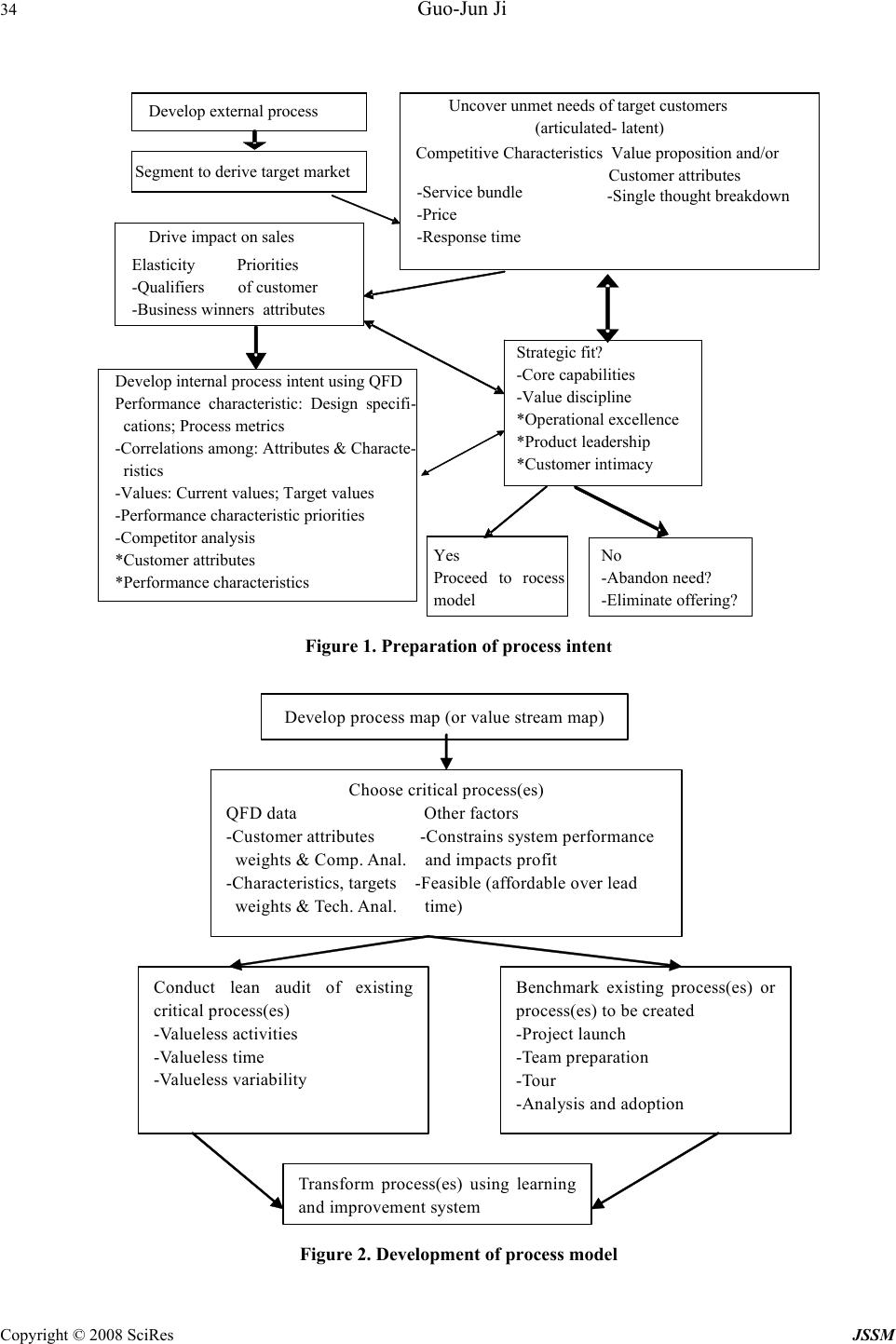 34 Guo-Jun Ji Copyright © 2008 SciRes JSSM Figure 1. Preparation o f p rocess inten t Develop process map (or value stream map) Choose critical process(es) QFD data Other factors -Customer attributes -Constrains system performance weights & Comp. Anal. and impacts profit -Characteristics, targets -Feasible (affordable over lead weights & Tech. Anal. time) Conduct lean audit of existing critical process(es) -Valueless activities -Valueless time -Valueless variability Benchmark existing process(es) or process(es) to be created -Project launch -Team preparation -Tour -Analysis and adoption Transform process(es) using learning and im p rovement s y stem Figure 2. Development of process model Develop external process Segment to derive target market Uncover unmet needs of target customers ( articulate d - latent ) Competitive Characteristics Value proposition and/or Customer attributes -Service bundle -Price -Response time -Single thought breakdown Drive impact on sales Elasticity Priorities -Qualifiers of customer -Business winners attributes Develop internal process intent using QFD Performance characteristic: Design specifi- cations; Process metrics -Correlations among: Attributes & Characte- ristics -Values: Current values; Target values -Performance characteristic priorities -Competitor analysis *Customer attributes *Performance characteristics Strategic fit? -Core capabilities -Value discipline *Operational excellence *Product leadership *Customer intimacy Yes Proceed to rocess model N o -Abandon need? -Eliminate offering? 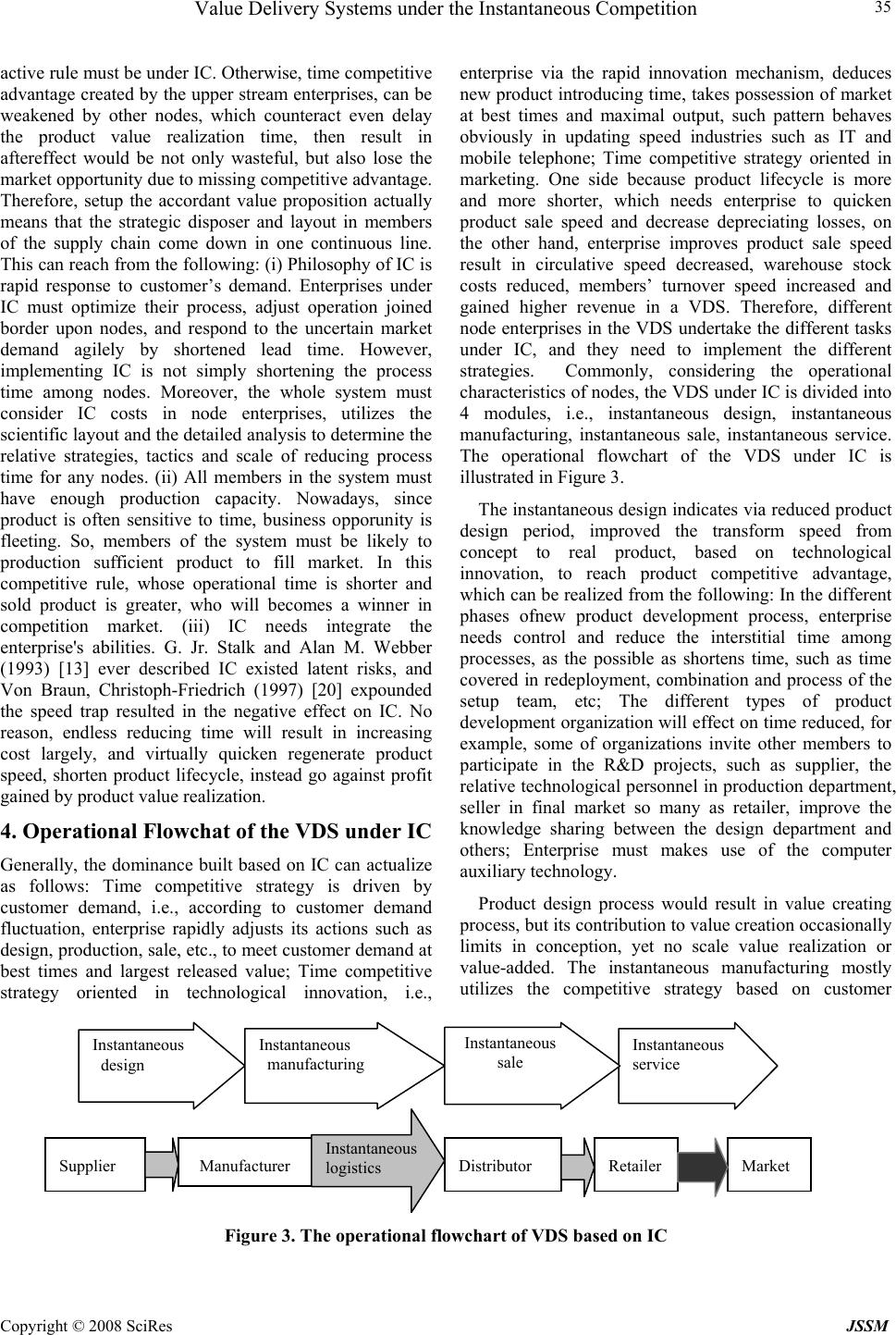 Value Delivery Systems under the Instantaneous Competition Copyright © 2008 SciRes JSSM 35 active rule must be under IC. Otherwise, time competitive advantage created by the upper stream enterprises, can be weakened by other nodes, which counteract even delay the product value realization time, then result in aftereffect would be not only wasteful, but also lose the market opportunity due to missing competitive advantage. Therefore, setup the accordant value proposition actually means that the strategic disposer and layout in members of the supply chain come down in one continuous line. This can reach from the following: (i) Philosophy of IC is rapid response to customer’s demand. Enterprises under IC must optimize their process, adjust operation joined border upon nodes, and respond to the uncertain market demand agilely by shortened lead time. However, implementing IC is not simply shortening the process time among nodes. Moreover, the whole system must consider IC costs in node enterprises, utilizes the scientific layout and the detailed analysis to determine the relative strategies, tactics and scale of reducing process time for any nodes. (ii) All members in the system must have enough production capacity. Nowadays, since product is often sensitive to time, business opporunity is fleeting. So, members of the system must be likely to production sufficient product to fill market. In this competitive rule, whose operational time is shorter and sold product is greater, who will becomes a winner in competition market. (iii) IC needs integrate the enterprise's abilities. G. Jr. Stalk and Alan M. Webber (1993) [13] ever described IC existed latent risks, and Von Braun, Christoph-Friedrich (1997) [20] expounded the speed trap resulted in the negative effect on IC. No reason, endless reducing time will result in increasing cost largely, and virtually quicken regenerate product speed, shorten product lifecycle, instead go against profit gained by product value realization. 4. Operational Flowchat of the VDS under IC Generally, the dominance built based on IC can actualize as follows: Time competitive strategy is driven by customer demand, i.e., according to customer demand fluctuation, enterprise rapidly adjusts its actions such as design, production, sale, etc., to meet customer demand at best times and largest released value; Time competitive strategy oriented in technological innovation, i.e., enterprise via the rapid innovation mechanism, deduces new product introducing time, takes possession of market at best times and maximal output, such pattern behaves obviously in updating speed industries such as IT and mobile telephone; Time competitive strategy oriented in marketing. One side because product lifecycle is more and more shorter, which needs enterprise to quicken product sale speed and decrease depreciating losses, on the other hand, enterprise improves product sale speed result in circulative speed decreased, warehouse stock costs reduced, members’ turnover speed increased and gained higher revenue in a VDS. Therefore, different node enterprises in the VDS undertake the different tasks under IC, and they need to implement the different strategies. Commonly, considering the operational characteristics of nodes, the VDS under IC is divided into 4 modules, i.e., instantaneous design, instantaneous manufacturing, instantaneous sale, instantaneous service. The operational flowchart of the VDS under IC is illustrated in Figure 3. The instantaneous design indicates via reduced product design period, improved the transform speed from concept to real product, based on technological innovation, to reach product competitive advantage, which can be realized from the following: In the different phases ofnew product development process, enterprise needs control and reduce the interstitial time among processes, as the possible as shortens time, such as time covered in redeployment, combination and process of the setup team, etc; The different types of product development organization will effect on time reduced, for example, some of organizations invite other members to participate in the R&D projects, such as supplier, the relative technological personnel in production department, seller in final market so many as retailer, improve the knowledge sharing between the design department and others; Enterprise must makes use of the computer auxiliary technology. Product design process would result in value creating process, but its contribution to value creation occasionally limits in conception, yet no scale value realization or value-added. The instantaneous manufacturing mostly utilizes the competitive strategy based on customer Figure 3. The operation al flowchart of VDS base d on IC Instantaneous design Instantaneous manufacturing Instantaneous service Supplier Manufacturer Distributor Retailer Market Instantaneous logistics Instantaneous sale 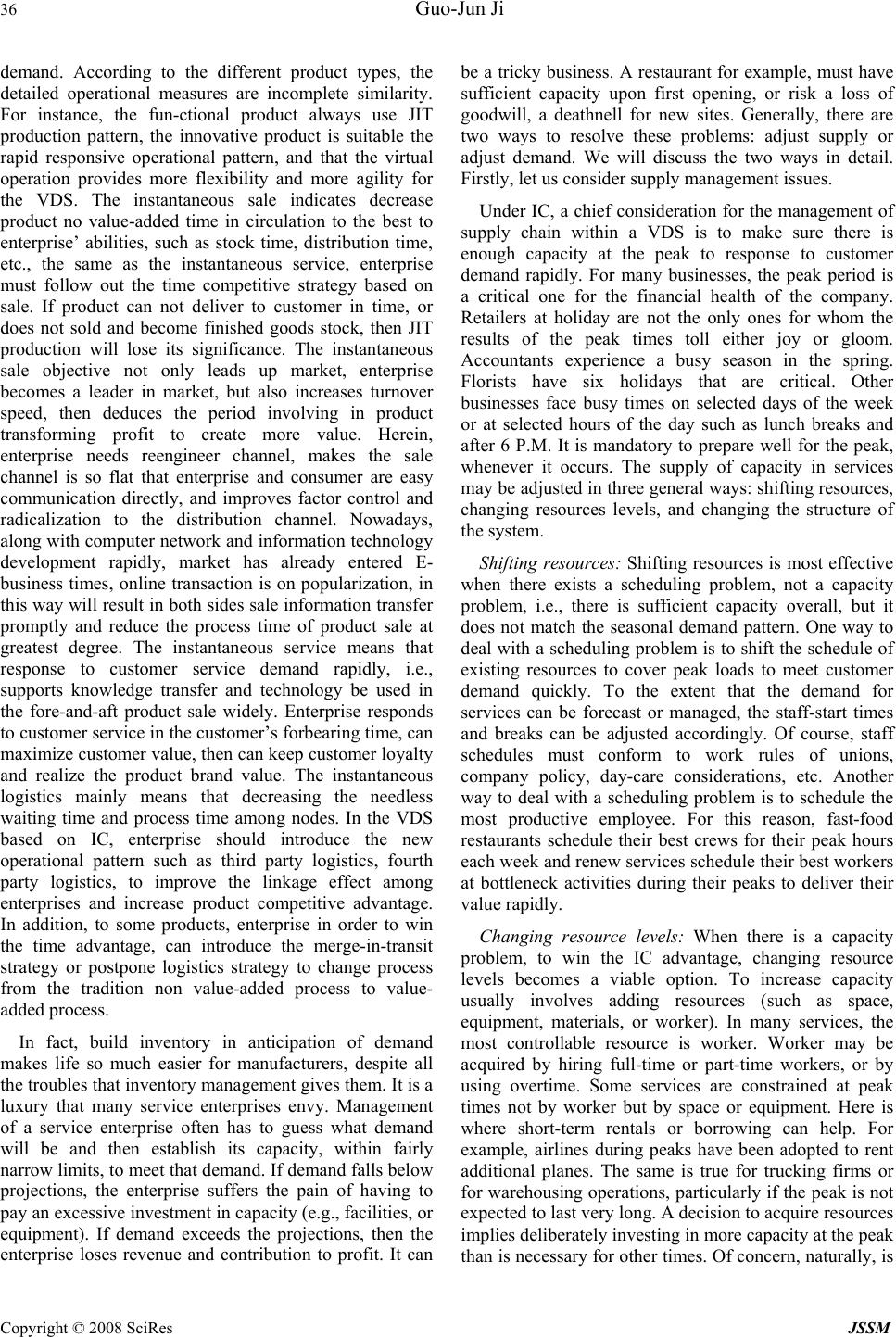 36 Guo-Jun Ji Copyright © 2008 SciRes JSSM demand. According to the different product types, the detailed operational measures are incomplete similarity. For instance, the fun-ctional product always use JIT production pattern, the innovative product is suitable the rapid responsive operational pattern, and that the virtual operation provides more flexibility and more agility for the VDS. The instantaneous sale indicates decrease product no value-added time in circulation to the best to enterprise’ abilities, such as stock time, distribution time, etc., the same as the instantaneous service, enterprise must follow out the time competitive strategy based on sale. If product can not deliver to customer in time, or does not sold and become finished goods stock, then JIT production will lose its significance. The instantaneous sale objective not only leads up market, enterprise becomes a leader in market, but also increases turnover speed, then deduces the period involving in product transforming profit to create more value. Herein, enterprise needs reengineer channel, makes the sale channel is so flat that enterprise and consumer are easy communication directly, and improves factor control and radicalization to the distribution channel. Nowadays, along with computer network and information technology development rapidly, market has already entered E- business times, online transaction is on popularization, in this way will result in both sides sale information transfer promptly and reduce the process time of product sale at greatest degree. The instantaneous service means that response to customer service demand rapidly, i.e., supports knowledge transfer and technology be used in the fore-and-aft product sale widely. Enterprise responds to customer service in the customer’s forbearing time, can maximize customer value, then can keep customer loyalty and realize the product brand value. The instantaneous logistics mainly means that decreasing the needless waiting time and process time among nodes. In the VDS based on IC, enterprise should introduce the new operational pattern such as third party logistics, fourth party logistics, to improve the linkage effect among enterprises and increase product competitive advantage. In addition, to some products, enterprise in order to win the time advantage, can introduce the merge-in-transit strategy or postpone logistics strategy to change process from the tradition non value-added process to value- added process. In fact, build inventory in anticipation of demand makes life so much easier for manufacturers, despite all the troubles that inventory management gives them. It is a luxury that many service enterprises envy. Management of a service enterprise often has to guess what demand will be and then establish its capacity, within fairly narrow limits, to meet that demand. If demand falls below projections, the enterprise suffers the pain of having to pay an excessive investment in capacity (e.g., facilities, or equipment). If demand exceeds the projections, then the enterprise loses revenue and contribution to profit. It can be a tricky business. A restaurant for example, must have sufficient capacity upon first opening, or risk a loss of goodwill, a deathnell for new sites. Generally, there are two ways to resolve these problems: adjust supply or adjust demand. We will discuss the two ways in detail. Firstly, let us consider supply management issues. Under IC, a chief consideration for the management of supply chain within a VDS is to make sure there is enough capacity at the peak to response to customer demand rapidly. For many businesses, the peak period is a critical one for the financial health of the company. Retailers at holiday are not the only ones for whom the results of the peak times toll either joy or gloom. Accountants experience a busy season in the spring. Florists have six holidays that are critical. Other businesses face busy times on selected days of the week or at selected hours of the day such as lunch breaks and after 6 P.M. It is mandatory to prepare well for the peak, whenever it occurs. The supply of capacity in services may be adjusted in three general ways: shifting resources, changing resources levels, and changing the structure of the system. Shifting resources: Shifting resources is most effective when there exists a scheduling problem, not a capacity problem, i.e., there is sufficient capacity overall, but it does not match the seasonal demand pattern. One way to deal with a scheduling problem is to shift the schedule of existing resources to cover peak loads to meet customer demand quickly. To the extent that the demand for services can be forecast or managed, the staff-start times and breaks can be adjusted accordingly. Of course, staff schedules must conform to work rules of unions, company policy, day-care considerations, etc. Another way to deal with a scheduling problem is to schedule the most productive employee. For this reason, fast-food restaurants schedule their best crews for their peak hours each week and renew services schedule their best workers at bottleneck activities during their peaks to deliver their value rapidly. Changing resource levels: When there is a capacity problem, to win the IC advantage, changing resource levels becomes a viable option. To increase capacity usually involves adding resources (such as space, equipment, materials, or worker). In many services, the most controllable resource is worker. Worker may be acquired by hiring full-time or part-time workers, or by using overtime. Some services are constrained at peak times not by worker but by space or equipment. Here is where short-term rentals or borrowing can help. For example, airlines during peaks have been adopted to rent additional planes. The same is true for trucking firms or for warehousing operations, particularly if the peak is not expected to last very long. A decision to acquire resources implies deliberately investing in more capacity at the peak than is necessary for other times. Of concern, naturally, is  Value Delivery Systems under the Instantaneous Competition Copyright © 2008 SciRes JSSM 37 paying for the resources. There are two ways to justify such excess: (1) Margins earned at the peak. Peak times may be so lucrative or the costs of setup excess capacity may be so cheap that it pays for the service to exist with excess capacity for the rest of the time. At it turns out, many service organizations are judged by customers on their ability to handle peak loads. Concern halls, amusement parks, golf courses and gymnasium are classic examples; (2) Countercyclical service. Some service facilities have multiple uses. Ski resorts that double as summer resorts are this examples, their size is dictated by the ski peak, but funded in part with summer resort revenues. The economic justifications behind these two scenarios are complicated. The duration of the peak, the prices that can be charged, the costs of maintaining the facility, the costs of operating it, and the off-peak demand and prices must all be considered. System restructuring: Whatever the system capacity, it is important to use it to the fullest under IC. There are several ways to restructure a VDS based on IC: perform activities concurrently, combine activities, standardize service pathways, untangle work flows in the layout, create cells, perform triage, provide support, and educate customers. (a) Perform activities concurrently: Sometimes, improvements in the rapid response to customers can be made if different resources perform tasks concurrently. For example, a credit card check may be performed concurrently while customer-mailing information and the order are processed. Even in cases where the same amount of work needs to be done, performing activities in parallel can shorten the customer’s flow time. (b) Combine activities. Opportunities to combine similar or sequential activities may also be encountered. By consolidating multiple activities into one and performing the activity by one set of resources, the system may benefit from shorter processing times and queue times. Using the example above, combining activities of credit card checks, gathering mailing information and order processing allow one worker to perform them in series without delay in-between. In the case of concurrent activities, different workers would perform them in parallel. © Standardize service paths. Some customers, types of customers or customer orders may follow different paths through the same set of activities. These paths are called patient pathways in healthcare, service paths in other services, and part routings in manufacturing. The system can become much more orderly and efficient by rearranging some pathways so they all follow the same route, and increase the IC advantage. (d) Untangle work flows in the layout. Once the paths are standardized, we may discover opportunities to change the layout within the process so that customers or orders flow in the same direction through the resources. Logical and physical flowcharts often are effective in identifying tangled workflows. For instance, logical flowcharts may reveal similar pathways for different types of customers, when a physical flowchart may show how they are processed within conflicting, tangled flows. By changing resources around, businesses may be able to untangle these flows, then reducing travel time for customers, orders and workers, i.e., improving enterprise IC ability. (e) Create cells. Here cells mean that a natural extension of linearizing pathways and untangling workflows. A cell includes a set of resources that is dedicated to similar customers, customer types or customer orders. Within the dedicated cells, workers and equipment are co-located within close proximity, and customers follow the same or similar workflows. Cells may decrease the variation of work arriving at any particular cell and permit similar customers to be served more rapidly than they otherwise would. Reductions in processing time and variability are possible because of increased homogeneity of work and added learning by workers. Generally, the staff within a cell should be cross-trained as much as possible to facilitate efficient processing and flexibility. It is important to note, however, that resources dedicated within cells, are usually unavailable to “help out” on work across cells. Therefore, learning within cells must be large enough to offset the loss of pooling across cells. (f) Triage. Triage mechanisms can serve to route customers, customer types or customer orders to appropriate cells. Triage mechanisms are widespread at present, especially “touchtone triage,” where we are asked to press “1” stands for one need, and “2 if our needs are something else. Triage, from the French word for “sorting” was originally a medical concept where a triage specialist decides whether a doctor or a nurse treats a patient. (g) Provide support. Workers need proper support to perform their jobs. A nurse may be more efficient if the right information, supplies, and assistance are provided at the right place and time. Additionally, circulating performance data, such as the number of patients treated, may in certain circumstances provide feedback and incentive to improve mean service time, service variability and conformance-to-standards. (h) Educate customers. Another mechanism that can effectively increase capacity and rapid responding time is to educate customers as to how to follow desired behavior. For example, a message may inform a caller when waiting on the telephone to have her order number and mailing address ready when a representative answers. An airline might benefit by informing people in line at the ticket counter to have a picture ID ready for security purposes. (i) Customer participation. Still another mechanism that can increase capacity and responding time is to persuade customers to do things for themselves. Hence, restaurants, during their peaks, may schedule a buffet service. In so doing they relinquish control over the portions provided people, but they can save substantially on the wait staff and kitchen help than they would otherwise require. Next, we will discuss the management of demand appeared in a VDS based on IC. The key to demand 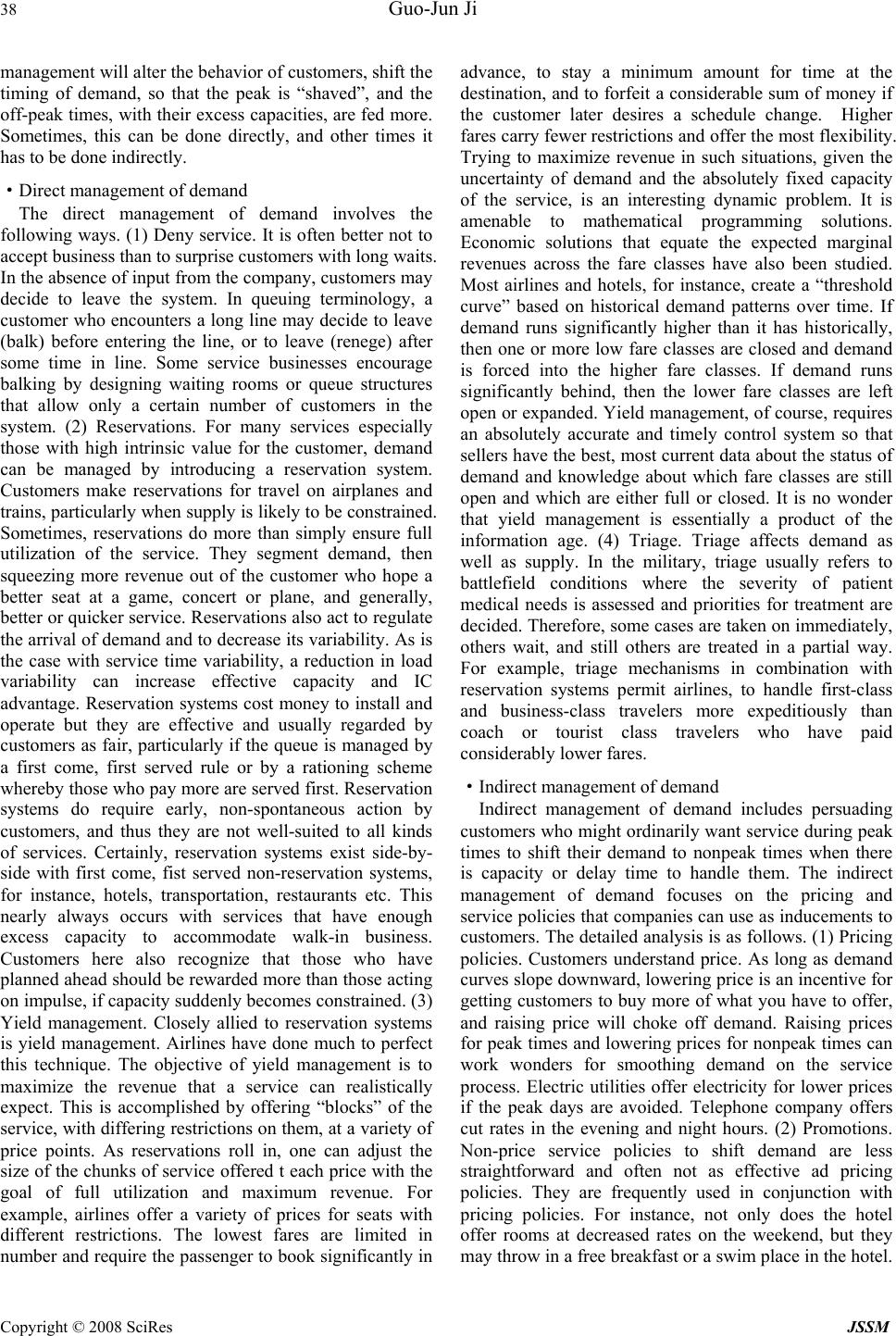 38 Guo-Jun Ji Copyright © 2008 SciRes JSSM management will alter the behavior of customers, shift the timing of demand, so that the peak is “shaved”, and the off-peak times, with their excess capacities, are fed more. Sometimes, this can be done directly, and other times it has to be done indirectly. ·Direct management of demand The direct management of demand involves the following ways. (1) Deny service. It is often better not to accept business than to surprise customers with long waits. In the absence of input from the company, customers may decide to leave the system. In queuing terminology, a customer who encounters a long line may decide to leave (balk) before entering the line, or to leave (renege) after some time in line. Some service businesses encourage balking by designing waiting rooms or queue structures that allow only a certain number of customers in the system. (2) Reservations. For many services especially those with high intrinsic value for the customer, demand can be managed by introducing a reservation system. Customers make reservations for travel on airplanes and trains, particularly when supply is likely to be constrained. Sometimes, reservations do more than simply ensure full utilization of the service. They segment demand, then squeezing more revenue out of the customer who hope a better seat at a game, concert or plane, and generally, better or quicker service. Reservations also act to regulate the arrival of demand and to decrease its variability. As is the case with service time variability, a reduction in load variability can increase effective capacity and IC advantage. Reservation systems cost money to install and operate but they are effective and usually regarded by customers as fair, particularly if the queue is managed by a first come, first served rule or by a rationing scheme whereby those who pay more are served first. Reservation systems do require early, non-spontaneous action by customers, and thus they are not well-suited to all kinds of services. Certainly, reservation systems exist side-by- side with first come, fist served non-reservation systems, for instance, hotels, transportation, restaurants etc. This nearly always occurs with services that have enough excess capacity to accommodate walk-in business. Customers here also recognize that those who have planned ahead should be rewarded more than those acting on impulse, if capacity suddenly becomes constrained. (3) Yield management. Closely allied to reservation systems is yield management. Airlines have done much to perfect this technique. The objective of yield management is to maximize the revenue that a service can realistically expect. This is accomplished by offering “blocks” of the service, with differing restrictions on them, at a variety of price points. As reservations roll in, one can adjust the size of the chunks of service offered t each price with the goal of full utilization and maximum revenue. For example, airlines offer a variety of prices for seats with different restrictions. The lowest fares are limited in number and require the passenger to book significantly in advance, to stay a minimum amount for time at the destination, and to forfeit a considerable sum of money if the customer later desires a schedule change. Higher fares carry fewer restrictions and offer the most flexibility. Trying to maximize revenue in such situations, given the uncertainty of demand and the absolutely fixed capacity of the service, is an interesting dynamic problem. It is amenable to mathematical programming solutions. Economic solutions that equate the expected marginal revenues across the fare classes have also been studied. Most airlines and hotels, for instance, create a “threshold curve” based on historical demand patterns over time. If demand runs significantly higher than it has historically, then one or more low fare classes are closed and demand is forced into the higher fare classes. If demand runs significantly behind, then the lower fare classes are left open or expanded. Yield management, of course, requires an absolutely accurate and timely control system so that sellers have the best, most current data about the status of demand and knowledge about which fare classes are still open and which are either full or closed. It is no wonder that yield management is essentially a product of the information age. (4) Triage. Triage affects demand as well as supply. In the military, triage usually refers to battlefield conditions where the severity of patient medical needs is assessed and priorities for treatment are decided. Therefore, some cases are taken on immediately, others wait, and still others are treated in a partial way. For example, triage mechanisms in combination with reservation systems permit airlines, to handle first-class and business-class travelers more expeditiously than coach or tourist class travelers who have paid considerably lower fares. ·Indirect management of demand Indirect management of demand includes persuading customers who might ordinarily want service during peak times to shift their demand to nonpeak times when there is capacity or delay time to handle them. The indirect management of demand focuses on the pricing and service policies that companies can use as inducements to customers. The detailed analysis is as follows. (1) Pricing policies. Customers understand price. As long as demand curves slope downward, lowering price is an incentive for getting customers to buy more of what you have to offer, and raising price will choke off demand. Raising prices for peak times and lowering prices for nonpeak times can work wonders for smoothing demand on the service process. Electric utilities offer electricity for lower prices if the peak days are avoided. Telephone company offers cut rates in the evening and night hours. (2) Promotions. Non-price service policies to shift demand are less straightforward and often not as effective ad pricing policies. They are frequently used in conjunction with pricing policies. For instance, not only does the hotel offer rooms at decreased rates on the weekend, but they may throw in a free breakfast or a swim place in the hotel. 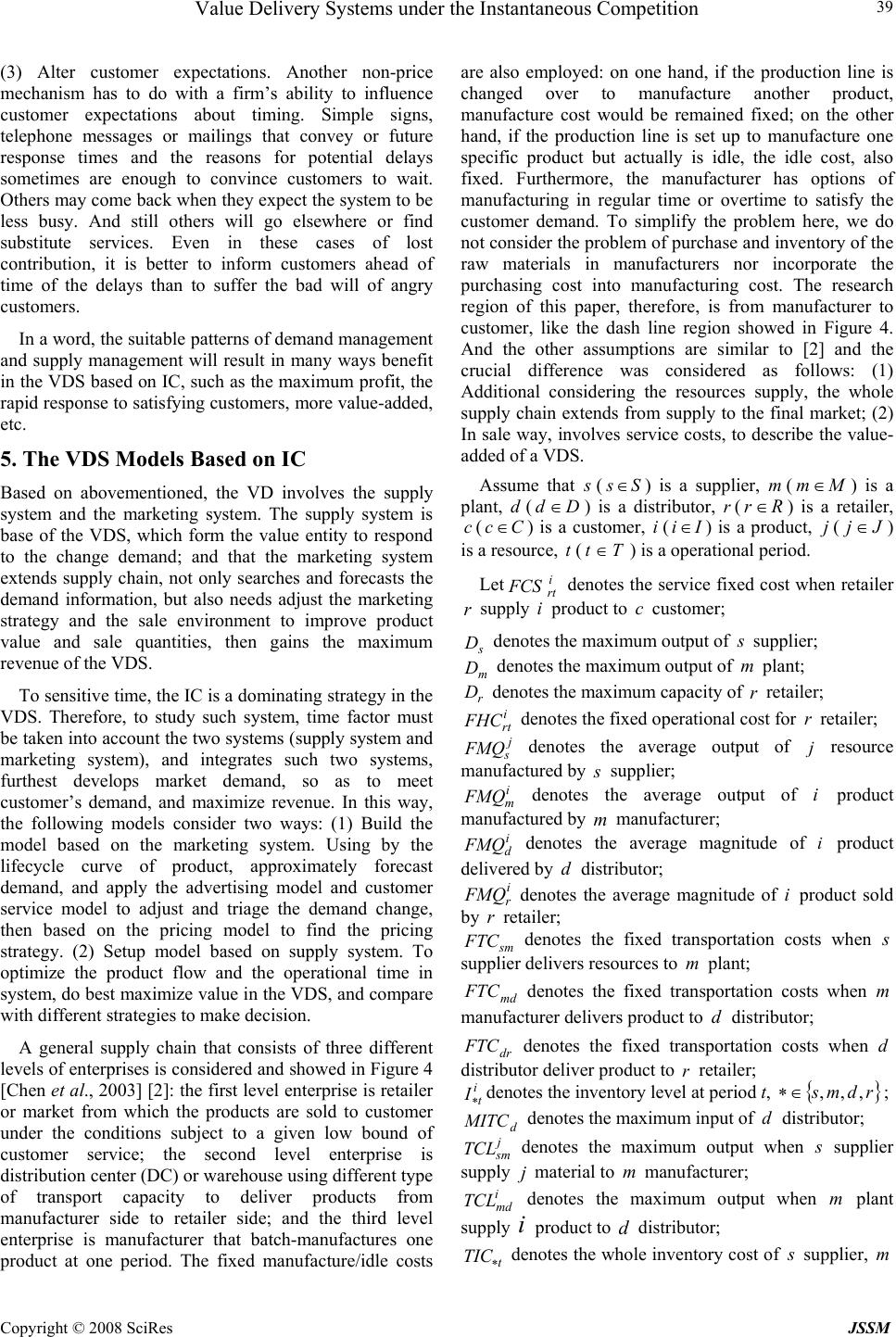 Value Delivery Systems under the Instantaneous Competition Copyright © 2008 SciRes JSSM 39 (3) Alter customer expectations. Another non-price mechanism has to do with a firm’s ability to influence customer expectations about timing. Simple signs, telephone messages or mailings that convey or future response times and the reasons for potential delays sometimes are enough to convince customers to wait. Others may come back when they expect the system to be less busy. And still others will go elsewhere or find substitute services. Even in these cases of lost contribution, it is better to inform customers ahead of time of the delays than to suffer the bad will of angry customers. In a word, the suitable patterns of demand management and supply management will result in many ways benefit in the VDS based on IC, such as the maximum profit, the rapid response to satisfying customers, more value-added, etc. 5. The VDS Models Based on IC Based on abovementioned, the VD involves the supply system and the marketing system. The supply system is base of the VDS, which form the value entity to respond to the change demand; and that the marketing system extends supply chain, not only searches and forecasts the demand information, but also needs adjust the marketing strategy and the sale environment to improve product value and sale quantities, then gains the maximum revenue of the VDS. To sensitive time, the IC is a dominating strategy in the VDS. Therefore, to study such system, time factor must be taken into account the two systems (supply system and marketing system), and integrates such two systems, furthest develops market demand, so as to meet customer’s demand, and maximize revenue. In this way, the following models consider two ways: (1) Build the model based on the marketing system. Using by the lifecycle curve of product, approximately forecast demand, and apply the advertising model and customer service model to adjust and triage the demand change, then based on the pricing model to find the pricing strategy. (2) Setup model based on supply system. To optimize the product flow and the operational time in system, do best maximize value in the VDS, and compare with different strategies to make decision. A general supply chain that consists of three different levels of enterprises is considered and showed in Figure 4 [Chen et al., 2003] [2]: the first level enterprise is retailer or market from which the products are sold to customer under the conditions subject to a given low bound of customer service; the second level enterprise is distribution center (DC) or warehouse using different type of transport capacity to deliver products from manufacturer side to retailer side; and the third level enterprise is manufacturer that batch-manufactures one product at one period. The fixed manufacture/idle costs are also employed: on one hand, if the production line is changed over to manufacture another product, manufacture cost would be remained fixed; on the other hand, if the production line is set up to manufacture one specific product but actually is idle, the idle cost, also fixed. Furthermore, the manufacturer has options of manufacturing in regular time or overtime to satisfy the customer demand. To simplify the problem here, we do not consider the problem of purchase and inventory of the raw materials in manufacturers nor incorporate the purchasing cost into manufacturing cost. The research region of this paper, therefore, is from manufacturer to customer, like the dash line region showed in Figure 4. And the other assumptions are similar to [2] and the crucial difference was considered as follows: (1) Additional considering the resources supply, the whole supply chain extends from supply to the final market; (2) In sale way, involves service costs, to describe the value- added of a VDS. Assume that s (Ss ∈ ) is a supplier, m(Mm ∈ ) is a plant, d(Dd ∈ ) is a distributor, r (R r ∈) is a retailer, c(Cc ∈ ) is a customer, i(Ii∈) is a product, j(Jj ∈ ) is a resource, t (Tt ∈ ) is a operational period. Let i rt FCS denotes the service fixed cost when retailer r supply i product to c customer; s D denotes the maximum output of s supplier; m D denotes the maximum output of m plant; r D denotes the maximum capacity of r retailer; i rt FHC denotes the fixed operational cost for r retailer; j s FMQ denotes the average output of j resource manufactured by s supplier; i m FMQ denotes the average output of i product manufactured by m manufacturer; i d FMQ denotes the average magnitude of i product delivered by d distributor; i r FMQ denotes the average magnitude of i product sold by r retailer; sm FTC denotes the fixed transportation costs when s supplier delivers resources to m plant; md FTC denotes the fixed transportation costs when m manufacturer delivers product to d distributor; dr FTC denotes the fixed transportation costs when d distributor deliver product to r retailer; it I∗denotes the inventory level at period t, {} rdms ,,,∈∗; d MITC denotes the maximum input of d distributor; j sm TCL denotes the maximum output when s supplier supply j material to m manufacturer; i md TCL denotes the maximum output when m plant supply i product to d distributor; t TIC∗ denotes the whole inventory cost of s supplier, m 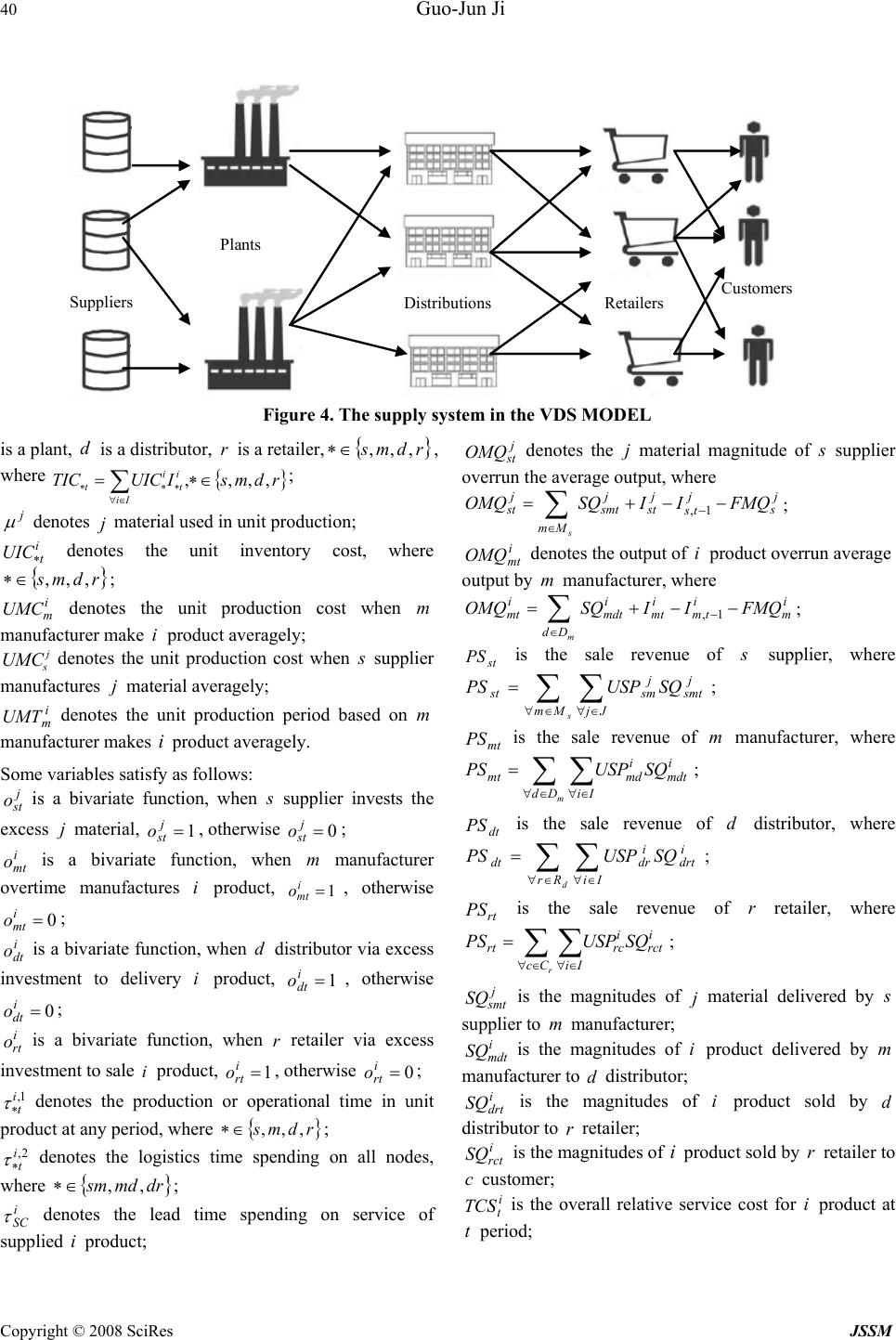 40 Guo-Jun Ji Copyright © 2008 SciRes JSSM Customers Plants Distributions Retailers Suppliers Figure 4. The supply system in the VDS MODEL is a plant, d is a distributor, r is a retailer, { } rdms ,,,∈∗ , where { } rdmsIUICTIC it Ii i t,,,, ∈∗= ∗ ∈∀ ∗∗ ∑; j μ denotes j material used in unit production; it UIC∗ denotes the unit inventory cost, where {} rdms ,,,∈∗ ; i m UMC denotes the unit production cost when m manufacturer make i product averagely; j s UMC denotes the unit production cost when s supplier manufactures j material averagely; i m UMT denotes the unit production period based on m manufacturer makes i product averagely. Some variables satisfy as follows: j st o is a bivariate function, when s supplier invests the excess j material, 1= j st o, otherwise 0= j st o; i mt o is a bivariate function, when m manufacturer overtime manufactures i product, 1= i mt o, otherwise 0= i mt o; i dt o is a bivariate function, when d distributor via excess investment to delivery i product, 1= i dt o, otherwise 0= i dt o; i rt o is a bivariate function, when r retailer via excess investment to sale i product, 1= i rt o, otherwise 0= i rt o; 1,it ∗ τ denotes the production or operational time in unit product at any period, where {} rdms ,,, ∈ ∗ ; 2,it∗ τ denotes the logistics time spending on all nodes, where {} drmdsm ,,∈∗ ; i SC τ denotes the lead time spending on service of supplied i product; j st OMQ denotes the j material magnitude of s supplier overrun the average output, where j s jts j st j smt Mm j st FMQIISQOMQ s −−+= − ∈ ∑ 1, ; i mt OMQ denotes the output of i product overrun average output by m manufacturer, where i m itm i mt i mdt Dd i mt FMQIISQOMQ m −−+= − ∈ ∑ 1, ; st PS is the sale revenue of s supplier, where ∑ ∑ ∈∀∈∀ = s MmJj j smt j smst SQUSPPS ; mt PS is the sale revenue of m manufacturer, where ∑ ∑ ∈∀∈∀ = m DdIi i mdt i mdmt SQUSPPS ; dt PS is the sale revenue of d distributor, where ∑ ∑ ∈∀∈∀ = d RrIi i drt i drdt SQUSPPS ; rt PS is the sale revenue of r retailer, where ∑ ∑ ∈∀∈∀ = r CcIi i rct i rcrt SQUSPPS ; j smt SQ is the magnitudes of j material delivered by s supplier to m manufacturer; i mdt SQ is the magnitudes of i product delivered by m manufacturer to d distributor; i drt SQ is the magnitudes of i product sold by d distributor to r retailer; i rct SQ is the magnitudes of i product sold by r retailer to c customer; i t TCS is the overall relative service cost for i product at t period; 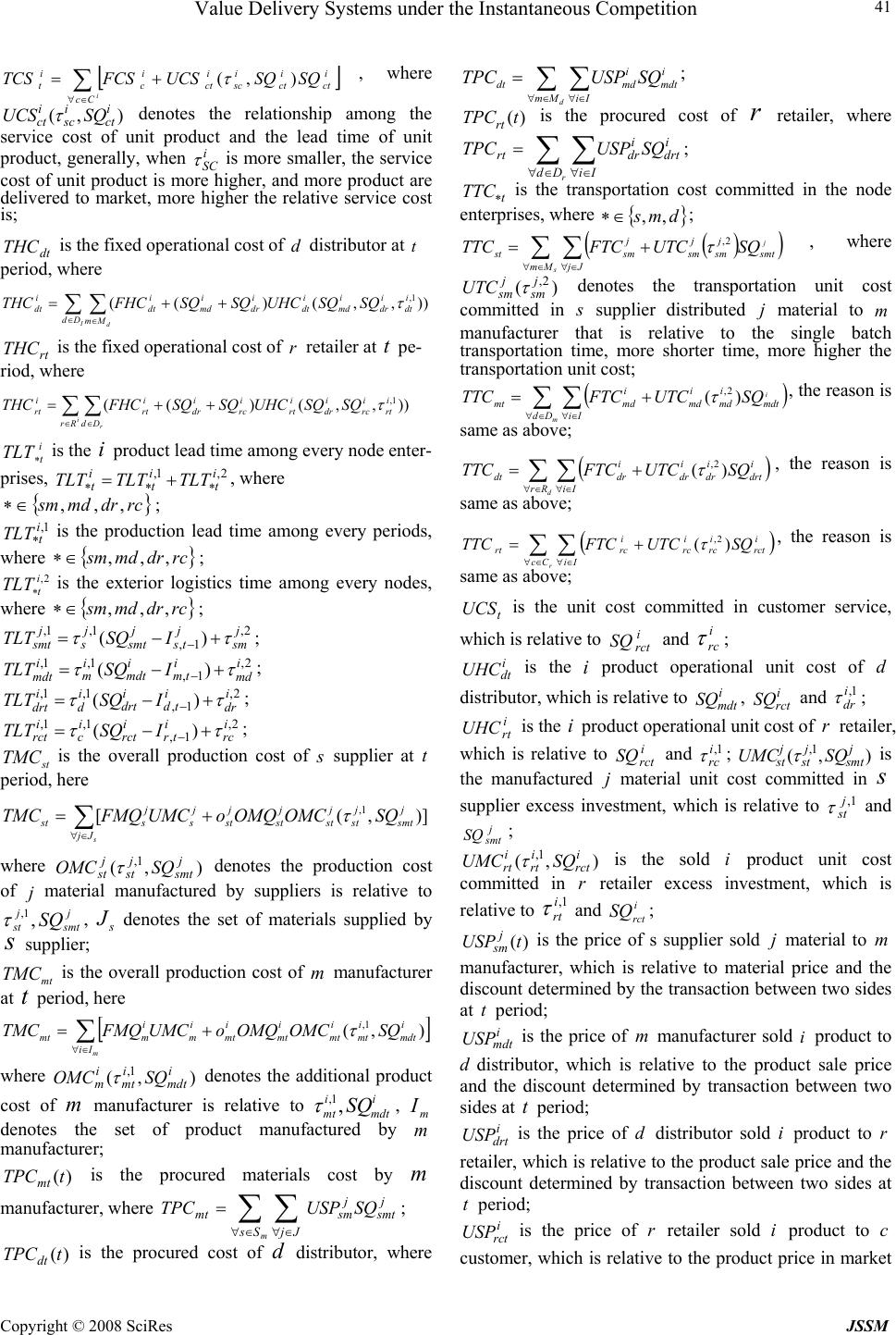 Value Delivery Systems under the Instantaneous Competition Copyright © 2008 SciRes JSSM 41 [ ] ∑ ∈∀ += i Cc i ct i ct i sc i ct i c i tSQSQUCSFCSTCS ),( τ , where ),( i ct i sc i ct SQUCS τ denotes the relationship among the service cost of unit product and the lead time of unit product, generally, when i SC τ is more smaller, the service cost of unit product is more higher, and more product are delivered to market, more higher the relative service cost is; dt THC is the fixed operational cost of d distributor at t period, where )),,()(( 1, ∑∑ ∈∈ ++= Id Dd i dt i dr i md i dt i dr i md i dt Mm i dt SQSQUHCSQSQFHCTHC τ rt THC is the fixed operational cost of r retailer at t pe- riod, where )),,()(( 1, ∑∑ ∈∈ ++= ir Rr i rt i rc i dr i rt i rc i dr i rt Dd i rt SQSQUHCSQSQFHCTHC τ i t TLT∗ is the i product lead time among every node enter- prises, 2,1,it it itTLTTLTTLT ∗∗∗ +=, where {} rcdrmdsm ,,,∈∗ ; 1,it TLT∗ is the production lead time among every periods, where {} rcdrmdsm ,,,∈∗ ; 2,i t TLT∗ is the exterior logistics time among every nodes, where {} rcdrmdsm ,,,∈∗; 2, 1, 1,1, )( j sm jts j smt j s j smt ISQTLT ττ +−=−; 2, 1, 1,1, )( i md itm i mdt i m i mdt ISQTLT ττ +−= −; 2, 1, 1,1,)( i dr itd i drt i d i drt ISQTLT ττ +−= −; 2, 1, 1,1,)( i rc itr i rct i c i rct ISQTLT ττ +−= −; st TMC is the overall production cost of s supplier at t period, here )],([ 1, j smt j st j st j st j st j s j s Jj st SQOMCOMQoUMCFMQTMC s τ += ∑ ∈∀ where ),(1, j smt j st j st SQOMC τ denotes the production cost of j material manufactured by suppliers is relative to j smt j st SQ, 1, τ , s J denotes the set of materials supplied by s supplier; mt TMC is the overall production cost of m manufacturer at t period, here [ ] ∑ ∈∀ += m Ii i mdt i mt i mt i mt i mt i m i mmt SQOMCOMQoUMCFMQTMC ),(1, τ where ),( 1, i mdt i mt i mSQOMC τ denotes the additional product cost of m manufacturer is relative to i mdt i mt SQ, 1, τ , m I denotes the set of product manufactured by m manufacturer; )(tTPCmt is the procured materials cost by m manufacturer, where j smt Ss j sm Jj mt SQUSPTPC m ∑∑ ∈∀∈∀ =; )(tTPCdt is the procured cost of d distributor, where i mdt MmIi i mddt SQUSPTPC d ∑ ∑ ∈∀∈∀ =; )(tTPCrt is the procured cost of r retailer, where i drt DdIi i drrt SQUSPTPC r ∑ ∑ ∈∀∈∀ =; t TTC∗ is the transportation cost committed in the node enterprises, where { } dms ,, ∈ ∗ ; () ( ) ∑ ∑ ∈∀∈∀ += s j MmJjsmt j sm j sm j smstSQUTCFTCTTC 2, τ , where )(2,j sm j sm UTC τ denotes the transportation unit cost committed in s supplier distributed j material to m manufacturer that is relative to the single batch transportation time, more shorter time, more higher the transportation unit cost; ( ) ∑ ∑ ∈∀∈∀ += m i DdIimdt i md i md i mdmt SQUTCFTCTTC )( 2, τ , the reason is same as above; ( ) ∑ ∑ ∈∀∈∀ += d RrIi i drt i dr i dr i drdt SQUTCFTCTTC )( 2, τ , the reason is same as above; ( ) ∑ ∑ ∈∀∈∀ += r CcIi i rct i rc i rc i rcrt SQUTCFTCTTC)( 2, τ , the reason is same as above; t UCS is the unit cost committed in customer service, which is relative to i rct SQ and i rc τ ; i dt UHC is the i product operational unit cost of d distributor, which is relative to i mdt SQ , i rct SQ and 1,i dr τ ; i rt UHC is the i product operational unit cost of r retailer, which is relative to i rct SQ and 1,i rc τ ; ),( 1, j smt j st j st SQUMC τ is the manufactured j material unit cost committed in s supplier excess investment, which is relative to 1,j st τ and j smt SQ ; ),( 1,i rct i rt i rt SQUMC τ is the sold i product unit cost committed in r retailer excess investment, which is relative to 1,i rt τ and i rct SQ ; )(tUSP j sm is the price of s supplier sold j material to m manufacturer, which is relative to material price and the discount determined by the transaction between two sides at t period; i mdt USP is the price of m manufacturer sold i product to d distributor, which is relative to the product sale price and the discount determined by transaction between two sides at t period; i drt USP is the price of d distributor sold i product to r retailer, which is relative to the product sale price and the discount determined by transaction between two sides at t period; i rct USP is the price of r retailer sold i product to c customer, which is relative to the product price in market 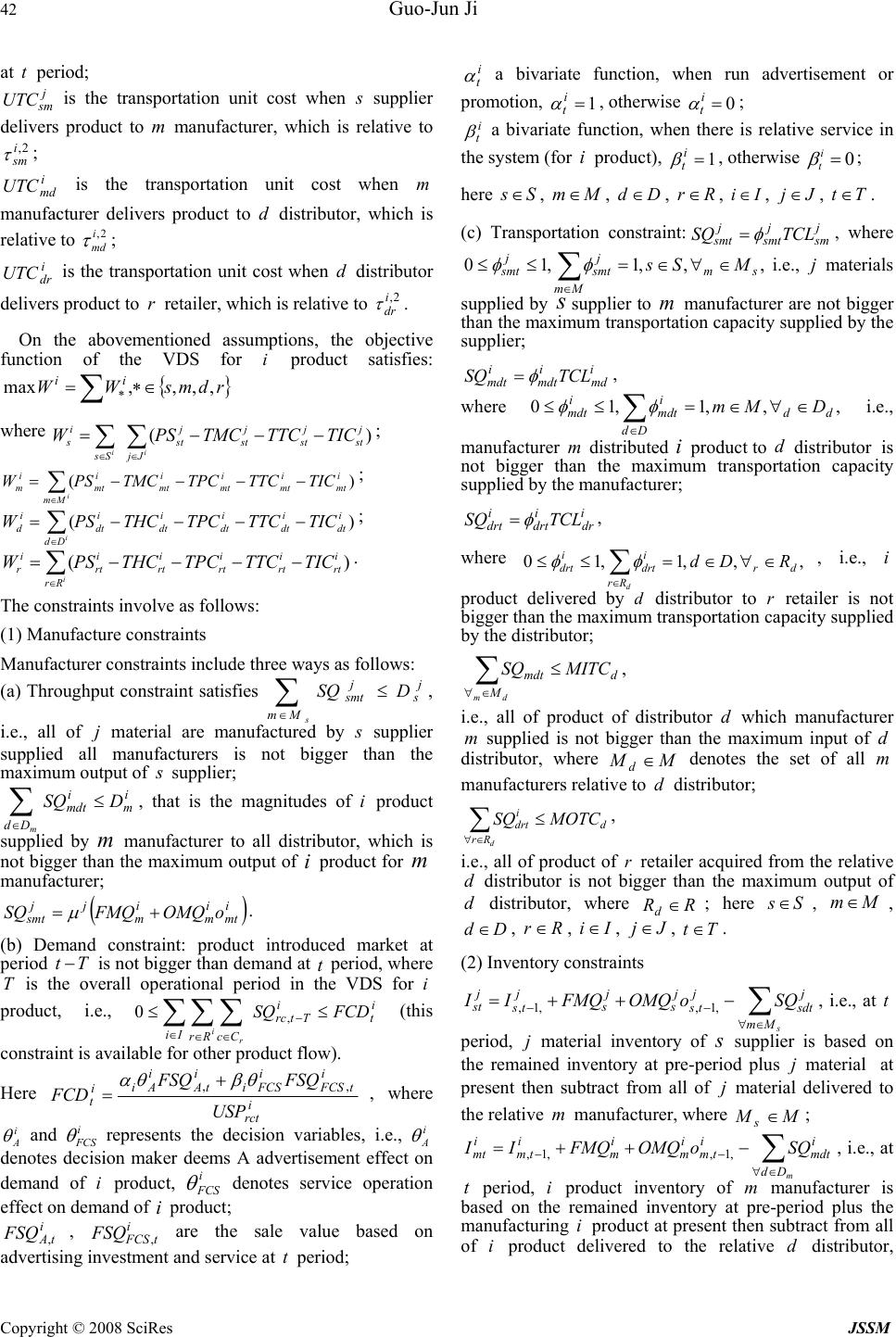 42 Guo-Jun Ji Copyright © 2008 SciRes JSSM at t period; j sm UTC is the transportation unit cost when s supplier delivers product to m manufacturer, which is relative to 2,i sm τ ; i md UTC is the transportation unit cost when m manufacturer delivers product to d distributor, which is relative to 2,i md τ ; i dr UTC is the transportation unit cost when d distributor delivers product to r retailer, which is relative to 2,i dr τ . On the abovementioned assumptions, the objective function of the VDS for i product satisfies: {} ∑∈∗=∗rdmsWW ii ,,,,max where )( j st j st j st j st JjSs i sTICTTCTMCPSW ii −−−= ∑∑∈∈ ; )( i mt i mt i mt i mt i mt Mm i mTICTTCTPCTMCPSW i −−−−= ∑ ∈ ; )( i dt i dt i dt i dt i dt Dd i dTICTTCTPCTHCPSW i −−−−=∑ ∈ ; )( i rt i rt i rt i rt i rt Rr i rTICTTCTPCTHCPSW i −−−−= ∑ ∈ . The constraints involve as follows: (1) Manufacture constraints Manufacturer constraints include three ways as follows: (a) Throughput constraint satisfies j s j smt Mm DSQ s ≤ ∑ ∈ , i.e., all of j material are manufactured by s supplier supplied all manufacturers is not bigger than the maximum output of s supplier; i m i mdt Dd DSQ m ≤ ∑ ∈ , that is the magnitudes of i product supplied by m manufacturer to all distributor, which is not bigger than the maximum output of i product for m manufacturer; ( ) i mt i m i m jj smt oOMQFMQSQ += μ . (b) Demand constraint: product introduced market at period Tt− is not bigger than demand at t period, where T is the overall operational period in the VDS for i product, i.e., i t iTtrc IiRrCc FCDSQ ir ≤≤ − ∈∈∈ ∑∑ ∑ , 0 (this constraint is available for other product flow). Here i rct itFCS i FCSi itA i Ai i tUSP FSQFSQ FCD ,, θβθα + =, where i A θ and i FCS θ represents the decision variables, i.e., i A θ denotes decision maker deems A advertisement effect on demand of i product, i FCS θ denotes service operation effect on demand of i product; itA FSQ ,, itFCS FSQ , are the sale value based on advertising investment and service at t period; i t α a bivariate function, when run advertisement or promotion, 1= i t α , otherwise 0= i t α ; i t β a bivariate function, when there is relative service in the system (for i product), 1= i t β , otherwise 0= i t β ; here Ss ∈ , Mm ∈ , Dd ∈ , R r ∈, Ii∈, Jj∈, Tt ∈ . (c) Transportation constraint:j sm j smt j smt TCLSQ φ =, where ,,,1,10 sm Mm j smt j smt MSs ∈∀∈=≤≤ ∑ ∈ φφ i.e., j materials supplied by s supplier to m manufacturer are not bigger than the maximum transportation capacity supplied by the supplier; i md i mdt i mdt TCLSQ φ =, where ,,,1,10 dd Dd i mdt i mdt DMm ∈∀∈=≤≤ ∑ ∈ φφ i.e., manufacturer m distributed i product to d distributor is not bigger than the maximum transportation capacity supplied by the manufacturer; i dr i drt i drt TCLSQ φ =, where ,,,1,10 dr Rr i drt i drt RDd d ∈∀∈=≤≤ ∑ ∈ φφ , i.e., i product delivered by d distributor to r retailer is not bigger than the maximum transportation capacity supplied by the distributor; d M mdt MITCSQ dm ≤ ∑ ∈∀ , i.e., all of product of distributor d which manufacturer m supplied is not bigger than the maximum input of d distributor, where MM d ∈ denotes the set of all m manufacturers relative to d distributor; d Rr i drt MOTCSQ d ≤ ∑ ∈∀ , i.e., all of product of r retailer acquired from the relative d distributor is not bigger than the maximum output of d distributor, where RRd∈; here Ss∈, Mm ∈ , Dd∈, R r ∈ , Ii ∈ , Jj ∈ , Tt∈. (2) Inventory constraints ∑ ∈∀ −− −++= s Mm j sdt jts j s j s jts j st SQoOMQFMQII ,1,,1, , i.e., at t period, j material inventory of s supplier is based on the remained inventory at pre-period plus j material at present then subtract from all of j material delivered to the relative m manufacturer, where MMs∈; ∑ ∈∀ −− −++= m Dd i mdt itm i m i m itm i mt SQoOMQFMQII,1,,1, , i.e., at t period, i product inventory of m manufacturer is based on the remained inventory at pre-period plus the manufacturing i product at present then subtract from all of i product delivered to the relative d distributor, 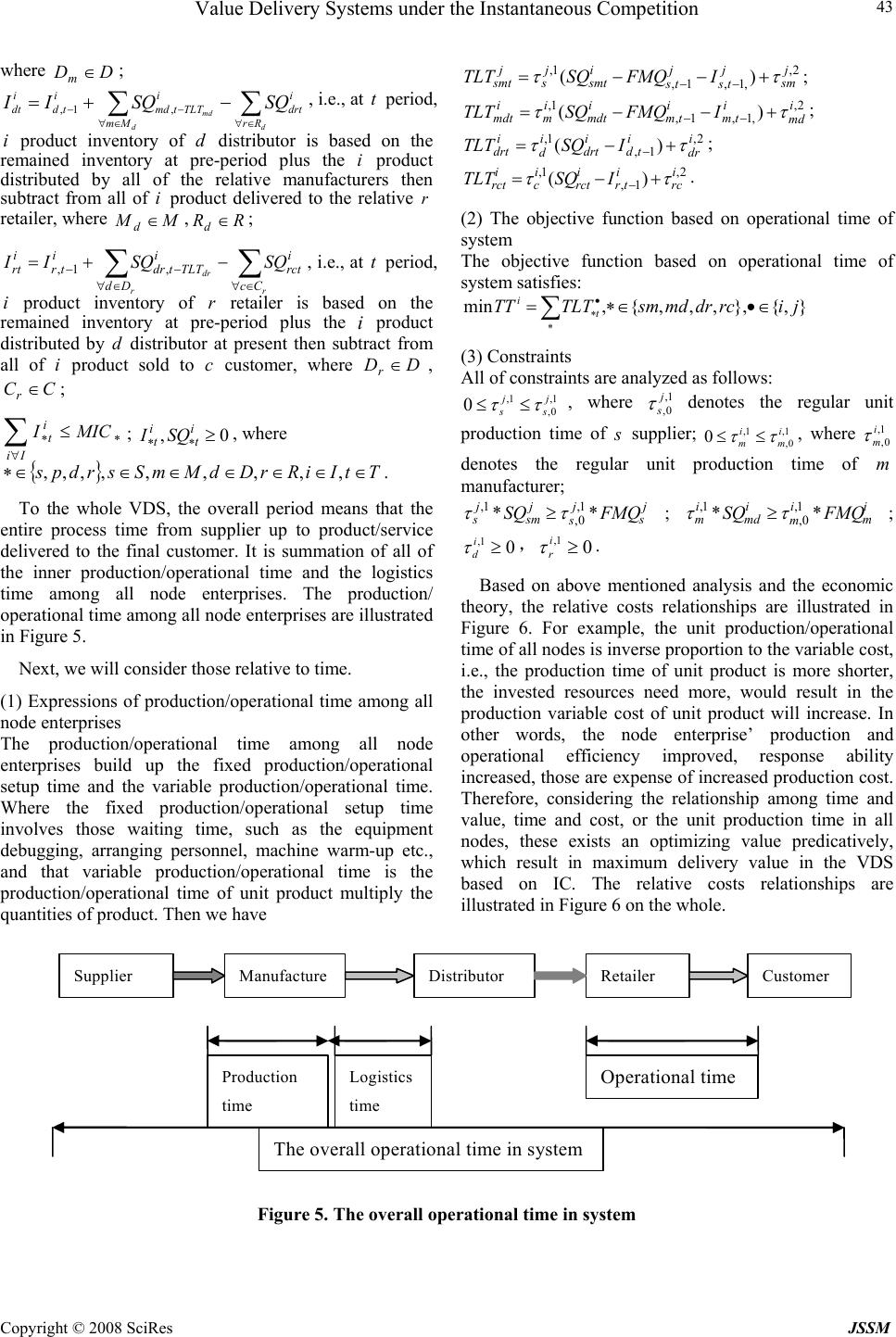 Value Delivery Systems under the Instantaneous Competition Copyright © 2008 SciRes JSSM 43 where DDm∈; ∑∑ ∈∀∈∀ −− −+= dd md Rr i drt Mm iTLTtmd itd i dt SQSQII ,1, , i.e., at t period, i product inventory of d distributor is based on the remained inventory at pre-period plus the i product distributed by all of the relative manufacturers then subtract from all of i product delivered to the relative r retailer, where MM d∈,RRd∈; ∑∑ ∈∀∈∀ −− −+= rr dr Cc i rct Dd iTLTtdr itr i rt SQSQII ,1, , i.e., at t period, i product inventory of r retailer is based on the remained inventory at pre-period plus the i product distributed by d distributor at present then subtract from all of i product sold to c customer, where DDr ∈ , CCr∈; ∑ ∀ ∗∗ ≤ Ii itMICI ; 0,≥ ∗∗ it itSQI , where {} TtIiRrDdMmSsrdps ∈ ∈∈ ∈ ∈∈∈∗ ,,,,,,,,, . To the whole VDS, the overall period means that the entire process time from supplier up to product/service delivered to the final customer. It is summation of all of the inner production/operational time and the logistics time among all node enterprises. The production/ operational time among all node enterprises are illustrated in Figure 5. Next, we will consider those relative to time. (1) Expressions of production/operational time among all node enterprises The production/operational time among all node enterprises build up the fixed production/operational setup time and the variable production/operational time. Where the fixed production/operational setup time involves those waiting time, such as the equipment debugging, arranging personnel, machine warm-up etc., and that variable production/operational time is the production/operational time of unit product multiply the quantities of product. Then we have 2, ,1,1, 1, )( j sm jts jts i smt j s j smt IFMQSQTLT ττ +−−=−− ; 2, ,1,1, 1, )( i md itm itm i mdt i m i mdt IFMQSQTLT ττ +−−= −− ; 2, 1, 1, )( i dr itd i drt i d i drt ISQTLT ττ +−= −; 2, 1, 1, )( i rc itr i rct i c i rct ISQTLT ττ +−= −. (2) The objective function based on operational time of system The objective function based on operational time of system satisfies: },{},,,,{,min jircdrmdsmTLTTT t i∈•∈∗= ∑ ∗ • ∗ (3) Constraints All of constraints are analyzed as follows: 1, 0, 1, 0j s j s ττ ≤≤ , where 1, 0, j s τ denotes the regular unit production time of s supplier; 1, 0, 1, 0i m i m ττ ≤≤ , where 1, 0, i m τ denotes the regular unit production time of m manufacturer; j s j s j sm j sFMQSQ ** 1, 0, 1, ττ ≥;i m i m i md i mFMQSQ ** 1, 0, 1, ττ ≥; 0 1, ≥ i d τ ,0 1, ≥ i r τ . Based on above mentioned analysis and the economic theory, the relative costs relationships are illustrated in Figure 6. For example, the unit production/operational time of all nodes is inverse proportion to the variable cost, i.e., the production time of unit product is more shorter, the invested resources need more, would result in the production variable cost of unit product will increase. In other words, the node enterprise’ production and operational efficiency improved, response ability increased, those are expense of increased production cost. Therefore, considering the relationship among time and value, time and cost, or the unit production time in all nodes, these exists an optimizing value predicatively, which result in maximum delivery value in the VDS based on IC. The relative costs relationships are illustrated in Figure 6 on the whole. Supplier Manufacture Distributor Retailer Customer Production time Logistics time Operational time The overall operational time in system Figure 5. The overall operational time in system 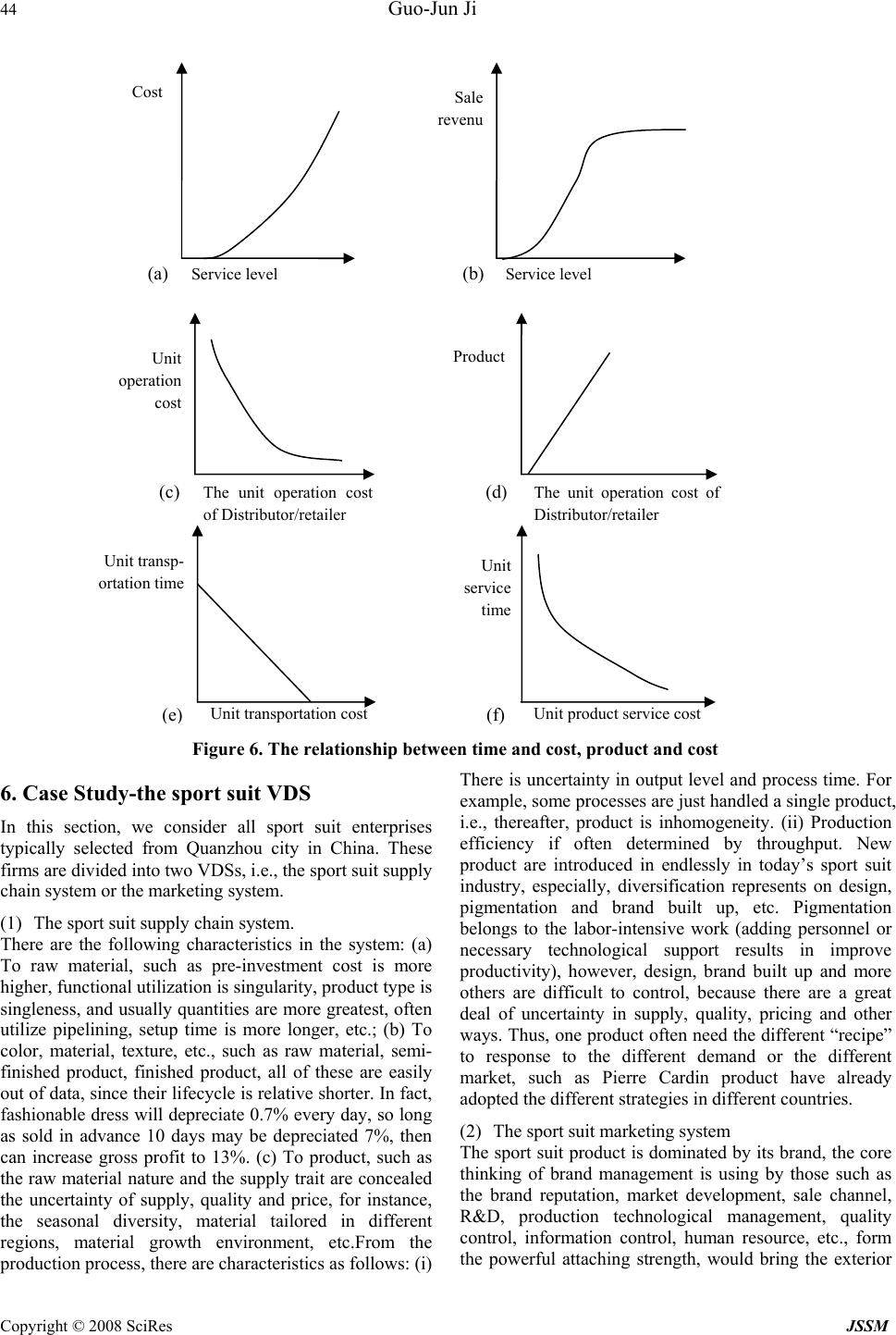 44 Guo-Jun Ji Copyright © 2008 SciRes JSSM Figure 6. The relationship between time and cost, product and cost 6. Case Study-the sport suit VDS In this section, we consider all sport suit enterprises typically selected from Quanzhou city in China. These firms are divided into two VDSs, i.e., the sport suit supply chain system or the marketing system. (1) The sport suit supply chain system. There are the following characteristics in the system: (a) To raw material, such as pre-investment cost is more higher, functional utilization is singularity, product type is singleness, and usually quantities are more greatest, often utilize pipelining, setup time is more longer, etc.; (b) To color, material, texture, etc., such as raw material, semi- finished product, finished product, all of these are easily out of data, since their lifecycle is relative shorter. In fact, fashionable dress will depreciate 0.7% every day, so long as sold in advance 10 days may be depreciated 7%, then can increase gross profit to 13%. (c) To product, such as the raw material nature and the supply trait are concealed the uncertainty of supply, quality and price, for instance, the seasonal diversity, material tailored in different regions, material growth environment, etc.From the production process, there are characteristics as follows: (i) There is uncertainty in output level and process time. For example, some processes are just handled a single product, i.e., thereafter, product is inhomogeneity. (ii) Production efficiency if often determined by throughput. New product are introduced in endlessly in today’s sport suit industry, especially, diversification represents on design, pigmentation and brand built up, etc. Pigmentation belongs to the labor-intensive work (adding personnel or necessary technological support results in improve productivity), however, design, brand built up and more others are difficult to control, because there are a great deal of uncertainty in supply, quality, pricing and other ways. Thus, one product often need the different “recipe” to response to the different demand or the different market, such as Pierre Cardin product have already adopted the different strategies in different countries. (2) The sport suit marketing system The sport suit product is dominated by its brand, the core thinking of brand management is using by those such as the brand reputation, market development, sale channel, R&D, production technological management, quality control, information control, human resource, etc., form the powerful attaching strength, would bring the exterior Cost Sale revenu (a) Service level (b) Servicelevel Unit service time Unit transportation costUnit product service cost ( e ) ( f ) Unit transp- ortation time Unit operation cost Product The unit operation cost of Distributor/retaile r (c) The unit operation cost of Distributor/retaile r (d) 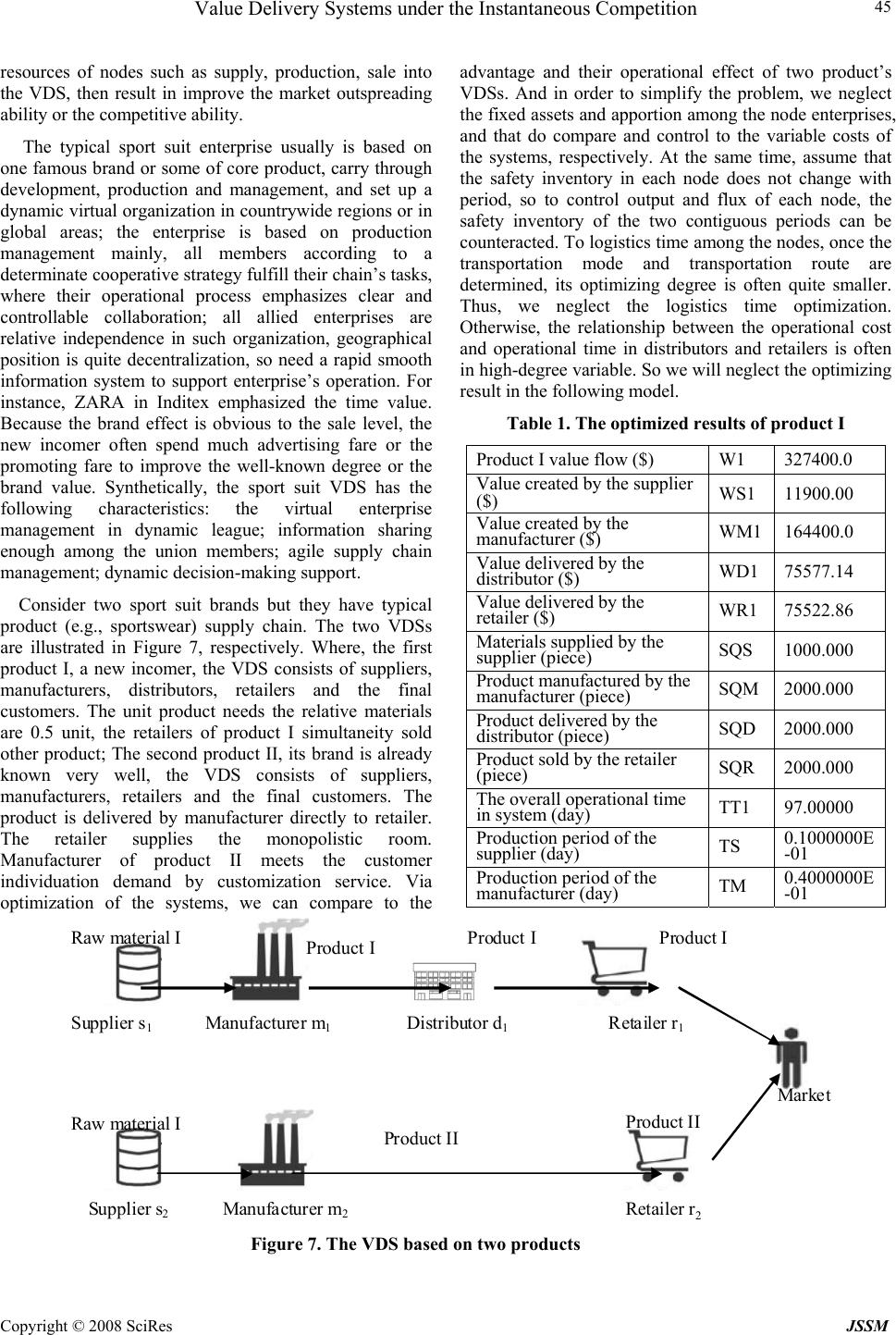 Value Delivery Systems under the Instantaneous Competition Copyright © 2008 SciRes JSSM 45 resources of nodes such as supply, production, sale into the VDS, then result in improve the market outspreading ability or the competitive ability. The typical sport suit enterprise usually is based on one famous brand or some of core product, carry through development, production and management, and set up a dynamic virtual organization in countrywide regions or in global areas; the enterprise is based on production management mainly, all members according to a determinate cooperative strategy fulfill their chain’s tasks, where their operational process emphasizes clear and controllable collaboration; all allied enterprises are relative independence in such organization, geographical position is quite decentralization, so need a rapid smooth information system to support enterprise’s operation. For instance, ZARA in Inditex emphasized the time value. Because the brand effect is obvious to the sale level, the new incomer often spend much advertising fare or the promoting fare to improve the well-known degree or the brand value. Synthetically, the sport suit VDS has the following characteristics: the virtual enterprise management in dynamic league; information sharing enough among the union members; agile supply chain management; dynamic decision-making support. Consider two sport suit brands but they have typical product (e.g., sportswear) supply chain. The two VDSs are illustrated in Figure 7, respectively. Where, the first product I, a new incomer, the VDS consists of suppliers, manufacturers, distributors, retailers and the final customers. The unit product needs the relative materials are 0.5 unit, the retailers of product I simultaneity sold other product; The second product II, its brand is already known very well, the VDS consists of suppliers, manufacturers, retailers and the final customers. The product is delivered by manufacturer directly to retailer. The retailer supplies the monopolistic room. Manufacturer of product II meets the customer individuation demand by customization service. Via optimization of the systems, we can compare to the advantage and their operational effect of two product’s VDSs. And in order to simplify the problem, we neglect the fixed assets and apportion among the node enterprises, and that do compare and control to the variable costs of the systems, respectively. At the same time, assume that the safety inventory in each node does not change with period, so to control output and flux of each node, the safety inventory of the two contiguous periods can be counteracted. To logistics time among the nodes, once the transportation mode and transportation route are determined, its optimizing degree is often quite smaller. Thus, we neglect the logistics time optimization. Otherwise, the relationship between the operational cost and operational time in distributors and retailers is often in high-degree variable. So we will neglect the optimizing result in the following model. Table 1. The optimized results of product I Product I value flow ($) W1 327400.0 Value created by the supplier ($) WS1 11900.00 Value created by the manufacturer ($) WM1 164400.0 Value delivered by the distributor ($) WD1 75577.14 Value delivered by the retailer ($) WR1 75522.86 Materials supplied by the supplier (piece) SQS 1000.000 Product manufactured by the manufacturer (piece) SQM 2000.000 Product delivered by the distributor (piece) SQD 2000.000 Product sold by the retailer (piece) SQR 2000.000 The overall operational time in system (day) TT1 97.00000 Production period of the supplier (day) TS 0.1000000E -01 Production period of the manufacturer (day) TM 0.4000000E -01 Manufacturer m2 Distributor d1 Manufacturer m1 Retailer r1 Retailer r2 Supplier s2 Product I Raw material I Raw material I Market Product I Product II Product I Product II Supplier s1 Figure 7. The VDS based on two products 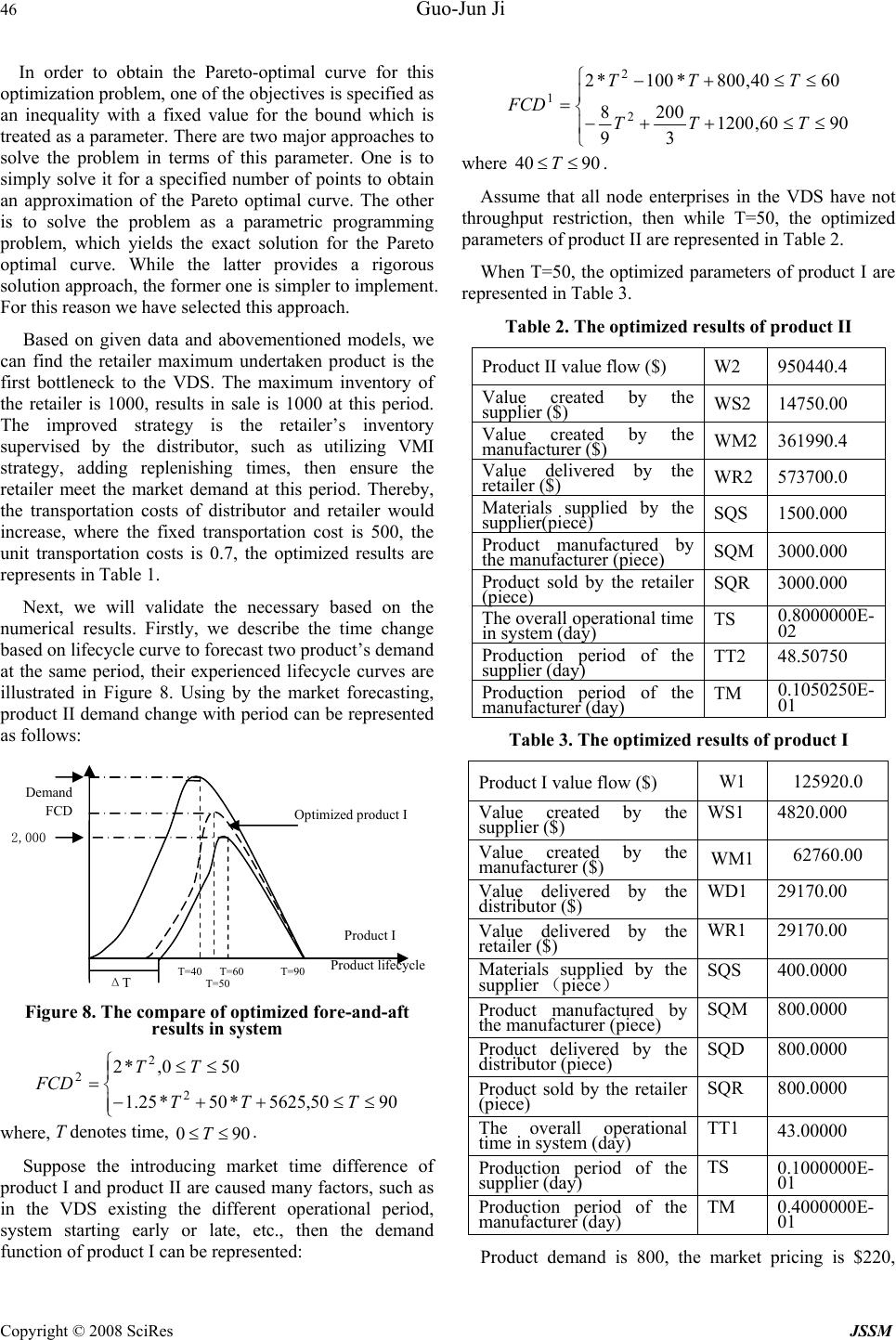 46 Guo-Jun Ji Copyright © 2008 SciRes JSSM In order to obtain the Pareto-optimal curve for this optimization problem, one of the objectives is specified as an inequality with a fixed value for the bound which is treated as a parameter. There are two major approaches to solve the problem in terms of this parameter. One is to simply solve it for a specified number of points to obtain an approximation of the Pareto optimal curve. The other is to solve the problem as a parametric programming problem, which yields the exact solution for the Pareto optimal curve. While the latter provides a rigorous solution approach, the former one is simpler to implement. For this reason we have selected this approach. Based on given data and abovementioned models, we can find the retailer maximum undertaken product is the first bottleneck to the VDS. The maximum inventory of the retailer is 1000, results in sale is 1000 at this period. The improved strategy is the retailer’s inventory supervised by the distributor, such as utilizing VMI strategy, adding replenishing times, then ensure the retailer meet the market demand at this period. Thereby, the transportation costs of distributor and retailer would increase, where the fixed transportation cost is 500, the unit transportation costs is 0.7, the optimized results are represents in Table 1. Next, we will validate the necessary based on the numerical results. Firstly, we describe the time change based on lifecycle curve to forecast two product’s demand at the same period, their experienced lifecycle curves are illustrated in Figure 8. Using by the market forecasting, product II demand change with period can be represented as follows: Figure 8. The compare of optimized fore-and-aft results in system ⎪ ⎩ ⎪ ⎨ ⎧ ≤≤++− ≤≤ = 9050,5625*50*25.1 500,*2 2 2 2 TTT TT FCD where, T denotes time, 900 ≤≤ T. Suppose the introducing market time difference of product I and product II are caused many factors, such as in the VDS existing the different operational period, system starting early or late, etc., then the demand function of product I can be represented: ⎪ ⎩ ⎪ ⎨ ⎧ ≤≤++− ≤≤+− = 9060,1200 3 200 9 8 6040,800*100*2 2 2 1 TTT TTT FCD where 9040 ≤ ≤ T. Assume that all node enterprises in the VDS have not throughput restriction, then while T=50, the optimized parameters of product II are represented in Table 2. When T=50, the optimized parameters of product I are represented in Table 3. Table 2. The optimized results of product II Product II value flow ($) W2 950440.4 Value created by the supplier ($) WS2 14750.00 Value created by the manufacturer ($) WM2 361990.4 Value delivered by the retailer ($) WR2 573700.0 Materials supplied by the supplier(piece) SQS 1500.000 Product manufactured by the manufacturer (piece) SQM 3000.000 Product sold by the retailer (piece) SQR 3000.000 The overall operational time in system (day) TS 0.8000000 E- 02 Production period of the supplier (day) TT2 48.50750 Production period of the manufacturer (day) TM 0.1050250E- 01 Table 3. The optimized results of product I Product I value flow ($) W1 125920.0 Value created by the supplier ($) WS1 4820.000 Value created by the manufacturer ($) WM1 62760.00 Value delivered by the distributor ($) WD1 29170.00 Value delivered by the retailer ($) WR1 29170.00 Materials supplied by the supplier (piece) SQS 400.0000 Product manufactured by the manufacturer (piece) SQM 800.0000 Product delivered by the distributor (piece) SQD 800.0000 Product sold by the retailer (piece) SQR 800.0000 The overall operational time in system (day) TT1 43.00000 Production period of the supplier (day) TS 0.1000000E- 01 Production period of the manufacturer (day) TM 0.4 000000E- 01 Product demand is 800, the market pricing is $220, Demand FCD Product I Optimized product I T=90 T=60 T=40 ΔT 2 , 000 T=50 Product lifecycle 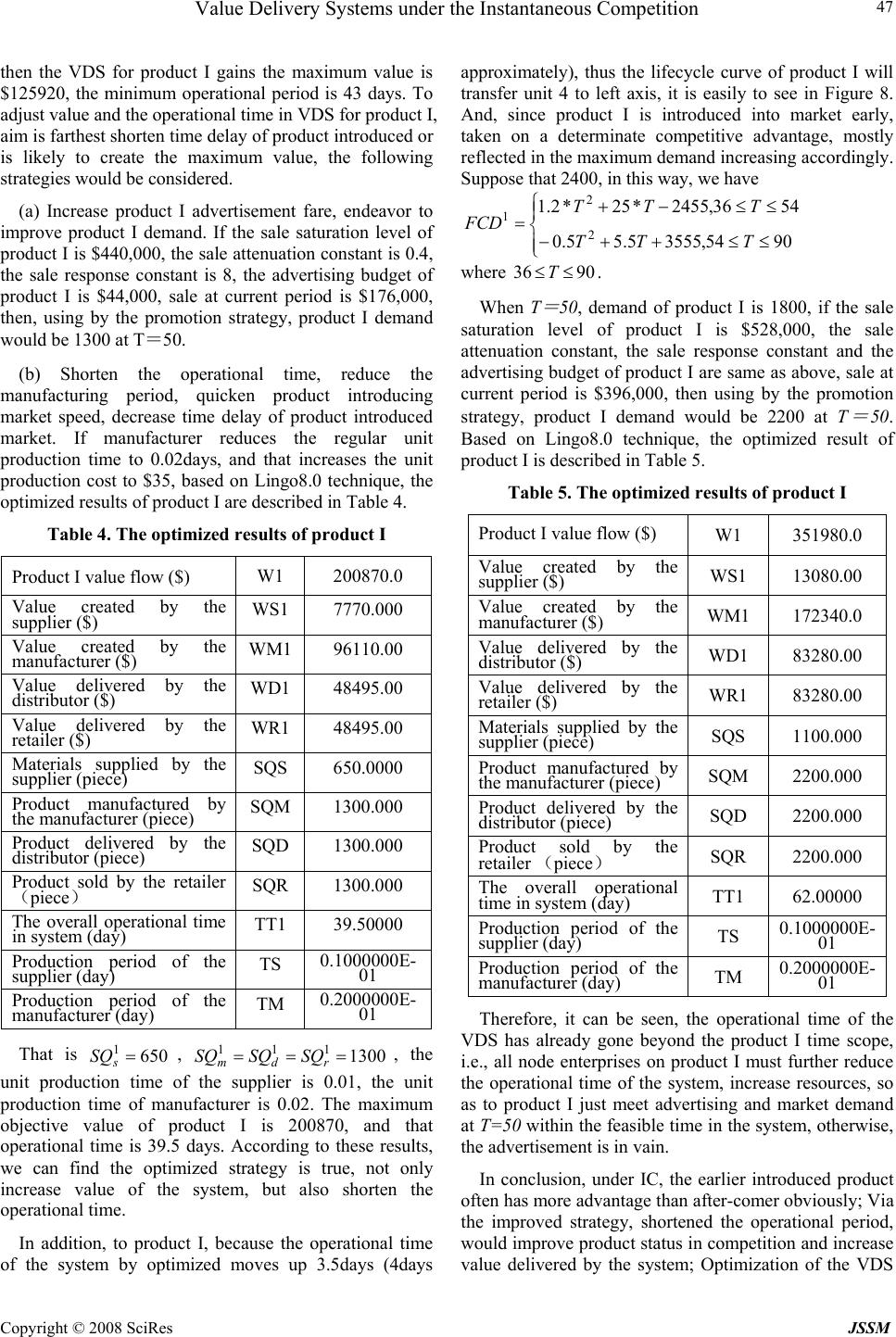 Value Delivery Systems under the Instantaneous Competition Copyright © 2008 SciRes JSSM 47 then the VDS for product I gains the maximum value is $125920, the minimum operational period is 43 days. To adjust value and the operational time in VDS for product I, aim is farthest shorten time delay of product introduced or is likely to create the maximum value, the following strategies would be considered. (a) Increase product I advertisement fare, endeavor to improve product I demand. If the sale saturation level of product I is $440,000, the sale attenuation constant is 0.4, the sale response constant is 8, the advertising budget of product I is $44,000, sale at current period is $176,000, then, using by the promotion strategy, product I demand would be 1300 at T=50. (b) Shorten the operational time, reduce the manufacturing period, quicken product introducing market speed, decrease time delay of product introduced market. If manufacturer reduces the regular unit production time to 0.02days, and that increases the unit production cost to $35, based on Lingo8.0 technique, the optimized results of product I are described in Table 4. Table 4. The optimized results of product I Product I value flow ($) W1 200870.0 Value created by the supplier ($) WS1 7770.000 Value created by the manufacturer ($) WM1 96110.00 Value delivered by the distributor ($) WD1 48495.00 Value delivered by the retailer ($) WR1 48495.00 Materials supplied by the supplier (piece) SQS 650.0000 Product manufactured by the manufacturer (piece) SQM 1300.000 Product delivered by the distributor (piece) SQD 1300.000 Product sold by the retailer (piece) SQR 1300.000 The overall operational time in system (day) TT1 39.50000 Production period of the supplier (day) TS 0.1000000E- 01 Production period of the manufacturer (day) TM 0.2 000000E- 01 That is 650 1= s SQ , 1300 111=== rdm SQSQSQ , the unit production time of the supplier is 0.01, the unit production time of manufacturer is 0.02. The maximum objective value of product I is 200870, and that operational time is 39.5 days. According to these results, we can find the optimized strategy is true, not only increase value of the system, but also shorten the operational time. In addition, to product I, because the operational time of the system by optimized moves up 3.5days (4days approximately), thus the lifecycle curve of product I will transfer unit 4 to left axis, it is easily to see in Figure 8. And, since product I is introduced into market early, taken on a determinate competitive advantage, mostly reflected in the maximum demand increasing accordingly. Suppose that 2400, in this way, we have ⎪ ⎩ ⎪ ⎨ ⎧ ≤≤++− ≤≤−+ = 9054,35555.55.0 5436,2455*25*2.1 2 2 1 TTT TTT FCD where 9036 ≤ ≤ T. When T = 50, demand of product I is 1800, if the sale saturation level of product I is $528,000, the sale attenuation constant, the sale response constant and the advertising budget of product I are same as above, sale at current period is $396,000, then using by the promotion strategy, product I demand would be 2200 at T = 50. Based on Lingo8.0 technique, the optimized result of product I is described in Table 5. Table 5. The optimized results of product I Product I value flow ($) W1 351980.0 Value created by the supplier ($) WS1 13080.00 Value created by the manufacturer ($) WM1 172340.0 Value delivered by the distributor ($) WD1 83280.00 Value delivered by the retailer ($) WR1 83280.00 Materials supplied by the supplier (piece) SQS 1100.000 Product manufactured by the manufacturer (piece) SQM 2200.000 Product delivered by the distributor (piece) SQD 2200.000 Product sold by the retailer (piece) SQR 2200.000 The overall operational time in system (day) TT1 62.00000 Production period of the supplier (day) TS 0.1000000 E- 01 Production period of the manufacturer (day) TM 0.2000000E- 01 Therefore, it can be seen, the operational time of the VDS has already gone beyond the product I time scope, i.e., all node enterprises on product I must further reduce the operational time of the system, increase resources, so as to product I just meet advertising and market demand at T=50 within the feasible time in the system, otherwise, the advertisement is in vain. In conclusion, under IC, the earlier introduced product often has more advantage than after-comer obviously; Via the improved strategy, shortened the operational period, would improve product status in competition and increase value delivered by the system; Optimization of the VDS 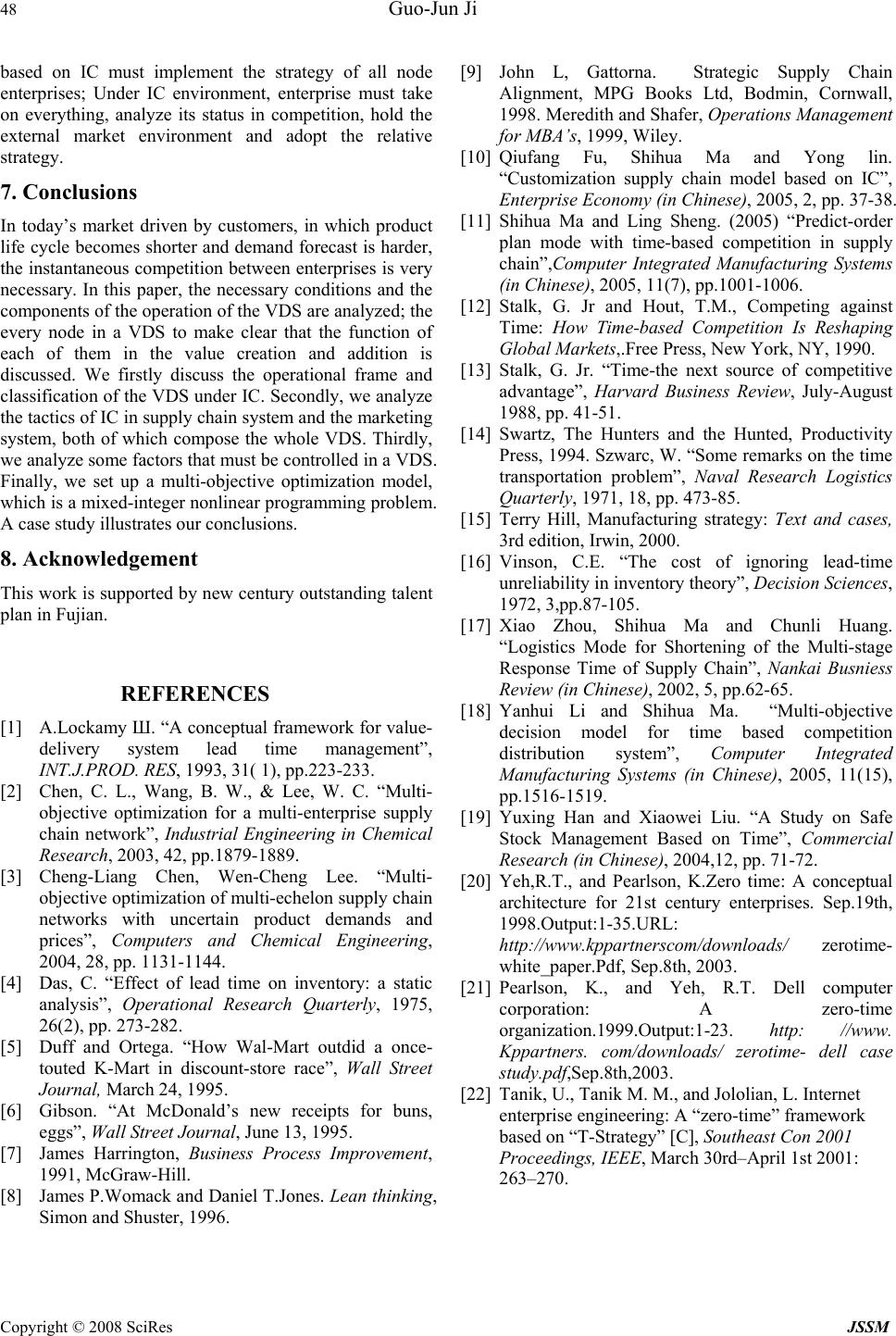 48 Guo-Jun Ji Copyright © 2008 SciRes JSSM based on IC must implement the strategy of all node enterprises; Under IC environment, enterprise must take on everything, analyze its status in competition, hold the external market environment and adopt the relative strategy. 7. Conclusions In today’s market driven by customers, in which product life cycle becomes shorter and demand forecast is harder, the instantaneous competition between enterprises is very necessary. In this paper, the necessary conditions and the components of the operation of the VDS are analyzed; the every node in a VDS to make clear that the function of each of them in the value creation and addition is discussed. We firstly discuss the operational frame and classification of the VDS under IC. Secondly, we analyze the tactics of IC in supply chain system and the marketing system, both of which compose the whole VDS. Thirdly, we analyze some factors that must be controlled in a VDS. Finally, we set up a multi-objective optimization model, which is a mixed-integer nonlinear programming problem. A case study illustrates our conclusions. 8. Acknowledgement This work is supported by new century outstanding talent plan in Fujian. REFERENCES [1] A.Lockamy Ш. “A conceptual framework for value- delivery system lead time management”, INT.J.PROD. RES, 1993, 31( 1), pp.223-233. [2] Chen, C. L., Wang, B. W., & Lee, W. C. “Multi- objective optimization for a multi-enterprise supply chain network”, Industrial Engineering in Chemical Research, 2003, 42, pp.1879-1889. [3] Cheng-Liang Chen, Wen-Cheng Lee. “Multi- objective optimization of multi-echelon supply chain networks with uncertain product demands and prices”, Computers and Chemical Engineering, 2004, 28, pp. 1131-1144. [4] Das, C. “Effect of lead time on inventory: a static analysis”, Operational Research Quarterly, 1975, 26(2), pp. 273-282. [5] Duff and Ortega. “How Wal-Mart outdid a once- touted K-Mart in discount-store race”, Wall Street Journal, March 24, 1995. [6] Gibson. “At McDonald’s new receipts for buns, eggs”, Wall Street Journal, June 13, 1995. [7] James Harrington, Business Process Improvement, 1991, McGraw-Hill. [8] James P.Womack and Daniel T.Jones. Lean thinking, Simon and Shuster, 1996. [9] John L, Gattorna. Strategic Supply Chain Alignment, MPG Books Ltd, Bodmin, Cornwall, 1998. Meredith and Shafer, Operations Management for MBA’s, 1999, Wiley. [10] Qiufang Fu, Shihua Ma and Yong lin. “Customization supply chain model based on IC”, Enterprise Economy (in Chinese), 2005, 2, pp. 37-38. [11] Shihua Ma and Ling Sheng. (2005) “Predict-order plan mode with time-based competition in supply chain”,Computer Integrated Manufacturing Systems (in Chinese), 2005, 11(7), pp.1001-1006. [12] Stalk, G. Jr and Hout, T.M., Competing against Time: How Time-based Competition Is Reshaping Global Markets,.Free Press, New York, NY, 1990. [13] Stalk, G. Jr. “Time-the next source of competitive advantage”, Harvard Business Review, July-August 1988, pp. 41-51. [14] Swartz, The Hunters and the Hunted, Productivity Press, 1994. Szwarc, W. “Some remarks on the time transportation problem”, Naval Research Logistics Quarterly, 1971, 18, pp. 473-85. [15] Terry Hill, Manufacturing strategy: Text and cases, 3rd edition, Irwin, 2000. [16] Vinson, C.E. “The cost of ignoring lead-time unreliability in inventory theory”, Decision Sciences, 1972, 3,pp.87-105. [17] Xiao Zhou, Shihua Ma and Chunli Huang. “Logistics Mode for Shortening of the Multi-stage Response Time of Supply Chain”, Nankai Busniess Review (in Chinese), 2002, 5, pp.62-65. [18] Yanhui Li and Shihua Ma. “Multi-objective decision model for time based competition distribution system”, Computer Integrated Manufacturing Systems (in Chinese), 2005, 11(15), pp.1516-1519. [19] Yuxing Han and Xiaowei Liu. “A Study on Safe Stock Management Based on Time”, Commercial Research (in Chinese), 2004,12, pp. 71-72. [20] Yeh,R.T., and Pearlson, K.Zero time: A conceptual architecture for 21st century enterprises. Sep.19th, 1998.Output:1-35.URL: http://www.kppartn erscom/down loa ds / zerotime- white_paper.Pdf, Sep.8th, 2003. [21] Pearlson, K., and Yeh, R.T. Dell computer corporation: A zero-time organization.1999.Output:1-23. http: //www. Kppartners. com/downloads/ zerotime- dell case study.pdf,Sep.8th,2003. [22] Tanik, U., Tanik M. M., and Jololian, L. Internet enterprise engineering: A “zero-time” framework based on “T-Strategy” [C], Southeast Con 2001 Proceedings, IEEE, March 30rd–April 1st 2001: 263–270. 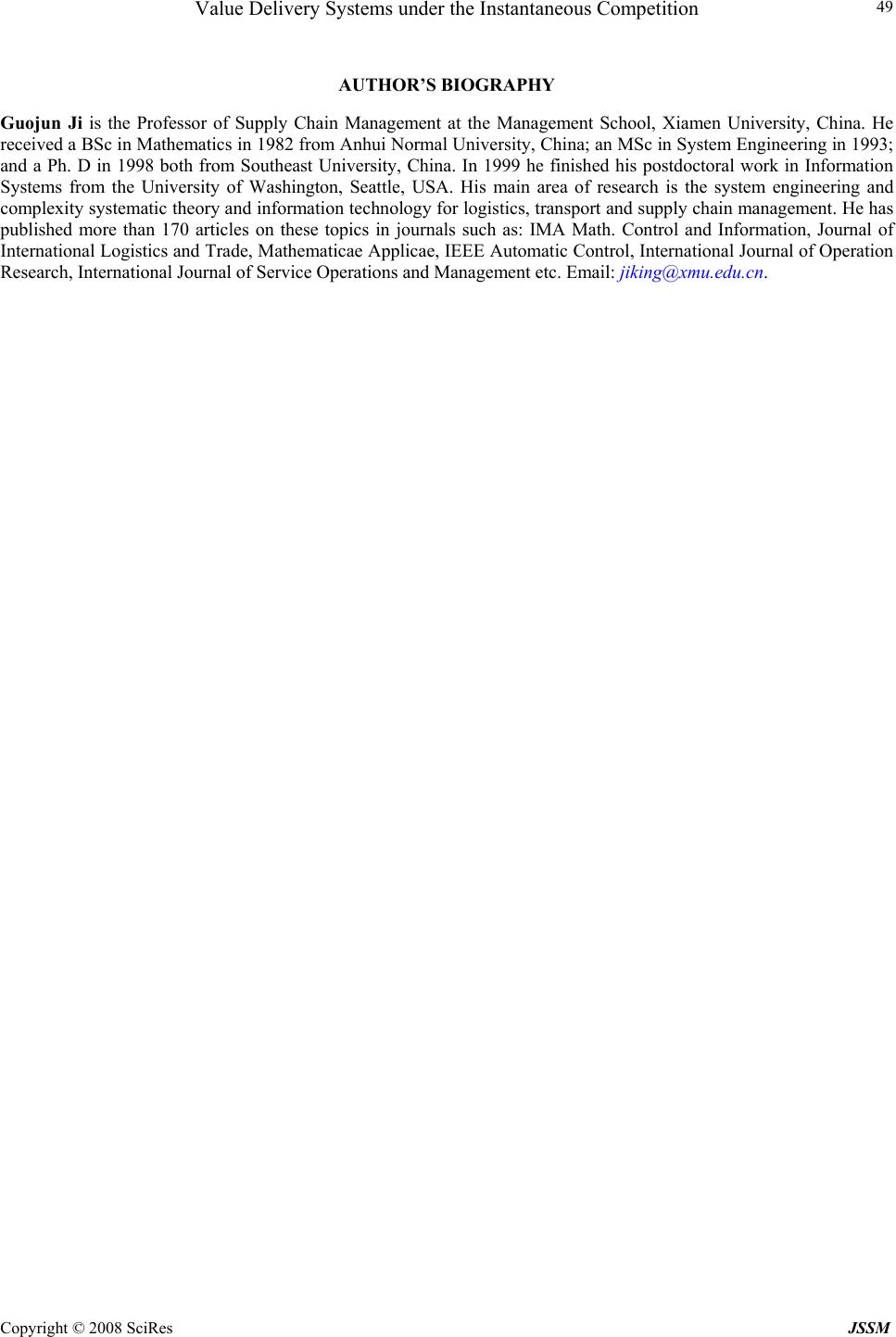 Value Delivery Systems under the Instantaneous Competition Copyright © 2008 SciRes JSSM 49 AUTHOR’S BI OG R A PHY Guojun Ji is the Professor of Supply Chain Management at the Management School, Xiamen University, China. He received a BSc in Mathematics in 1982 from Anhui Normal University, China; an MSc in System Engineering in 1993; and a Ph. D in 1998 both from Southeast University, China. In 1999 he finished his postdoctoral work in Information Systems from the University of Washington, Seattle, USA. His main area of research is the system engineering and complexity systematic theory and information technology for logistics, transport and supply chain management. He has published more than 170 articles on these topics in journals such as: IMA Math. Control and Information, Journal of International Logistics and Trade, Mathematicae Applicae, IEEE Automatic Control, International Journal of Operation Research, International Journal of Service Operations and Management etc. Email: jiking@xmu.edu.cn.  Value Delivery Systems under the Instantaneous Competition Copyright © 2008 SciRes JSSM 49 |

